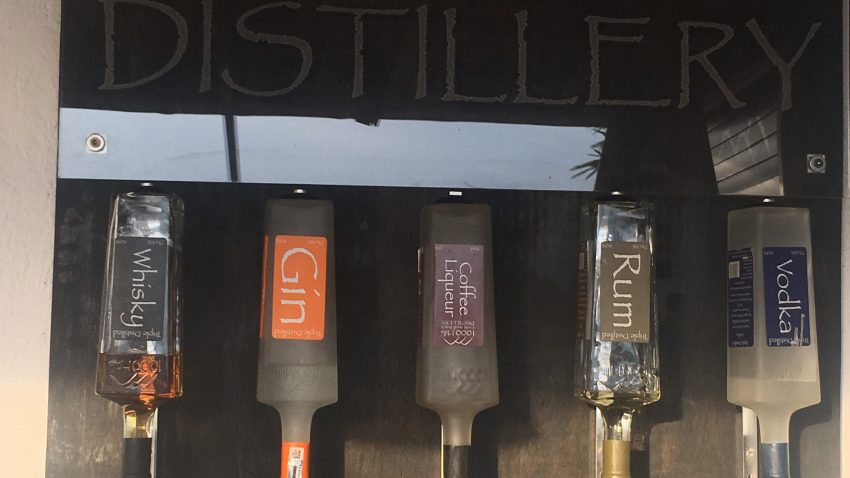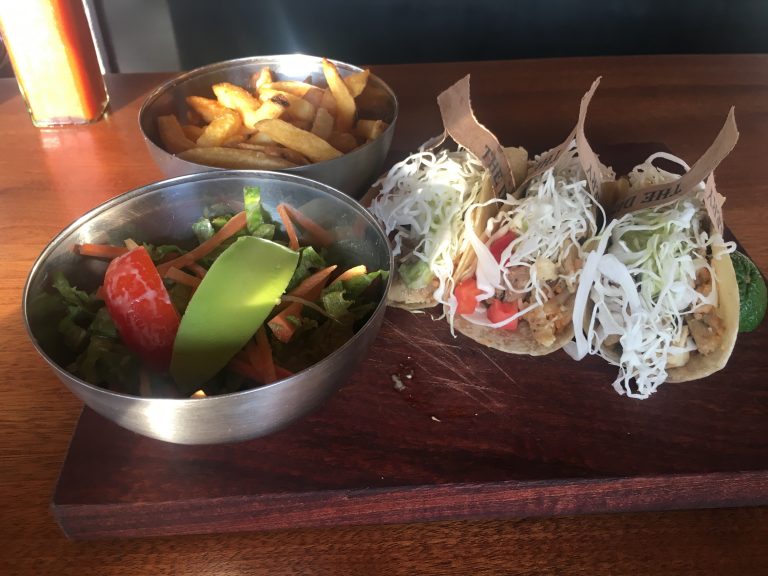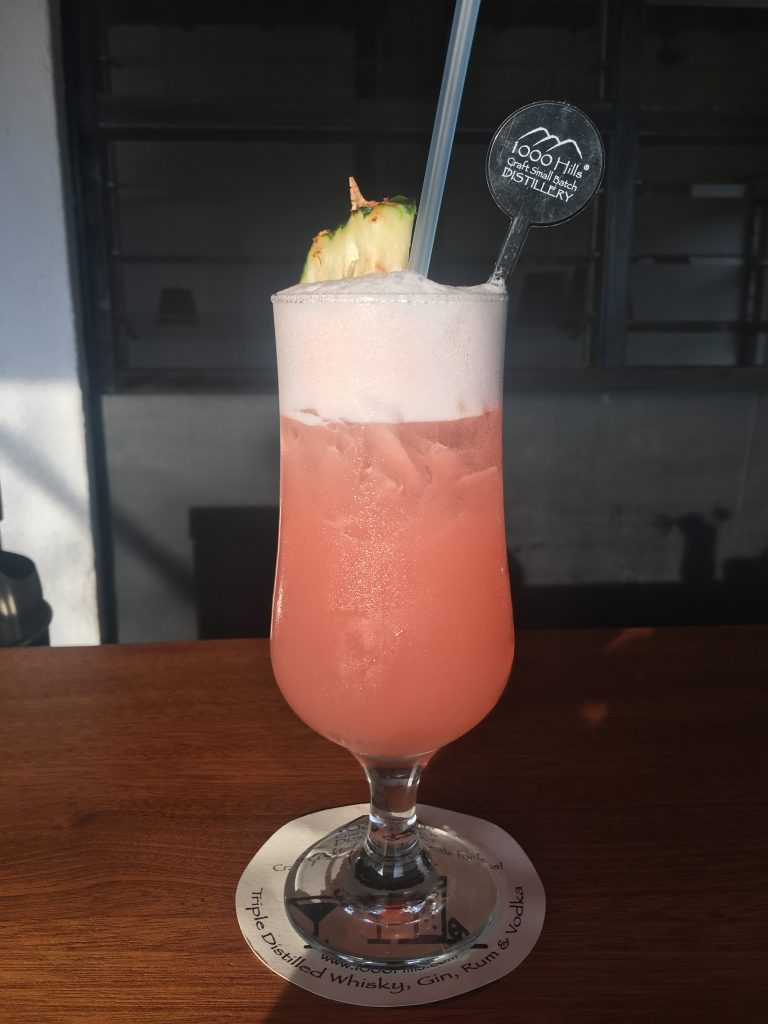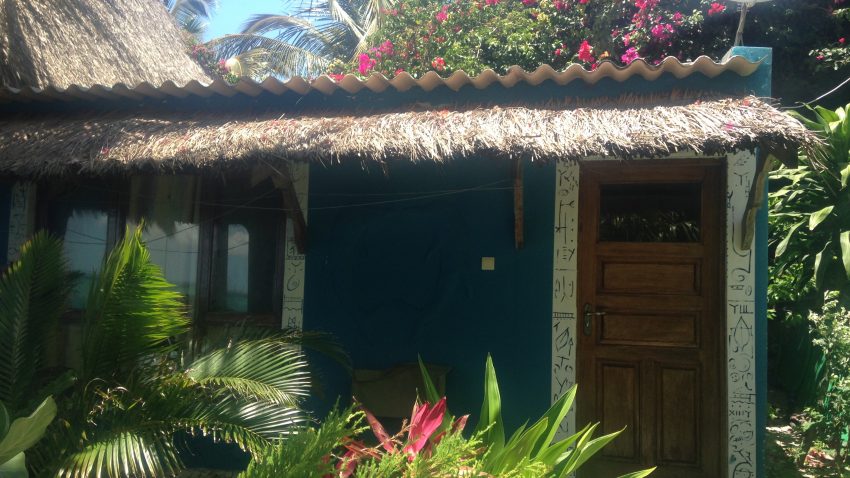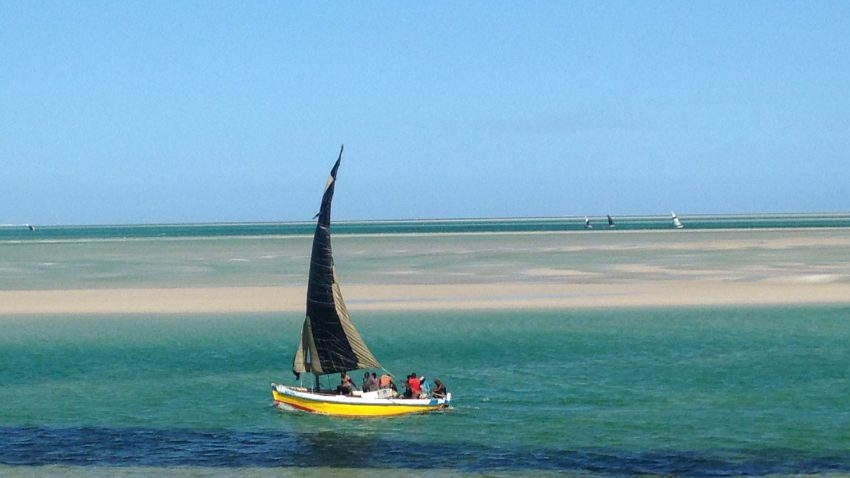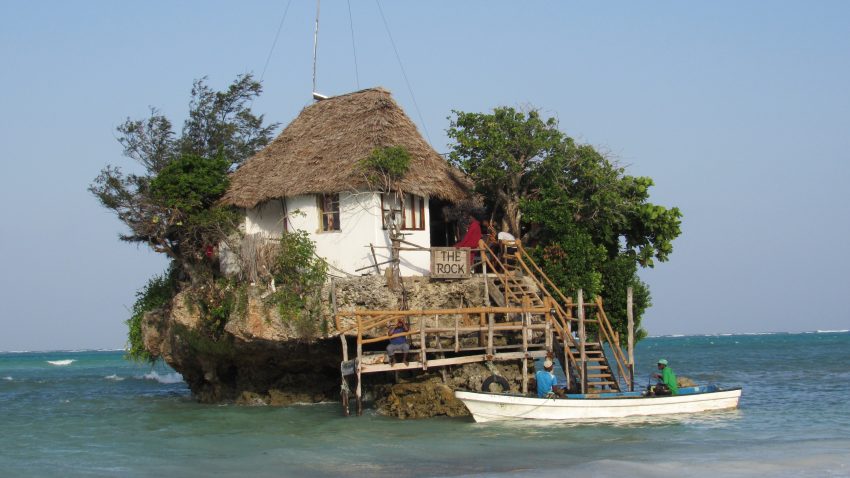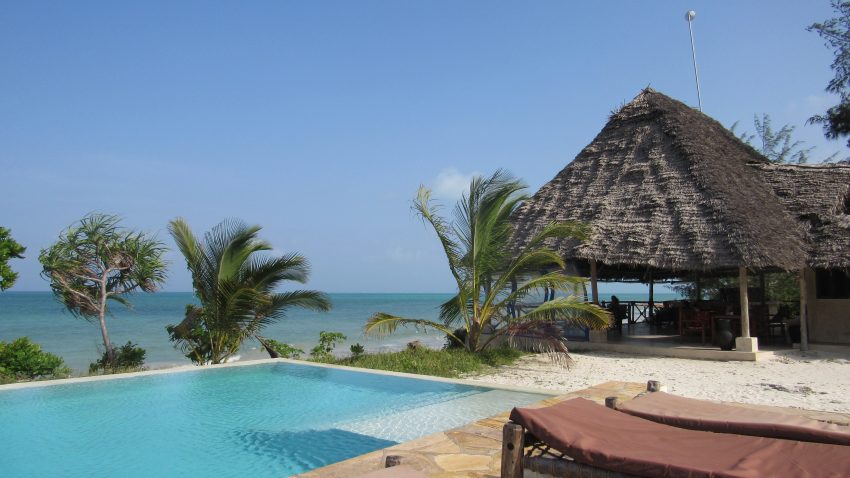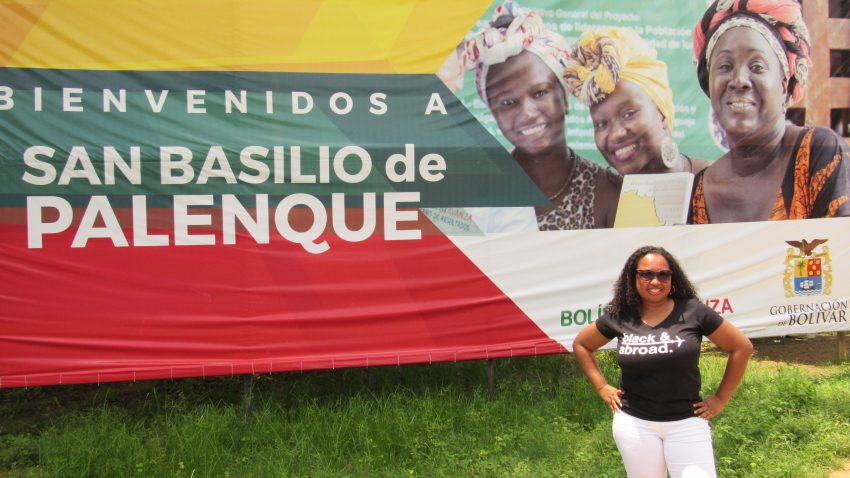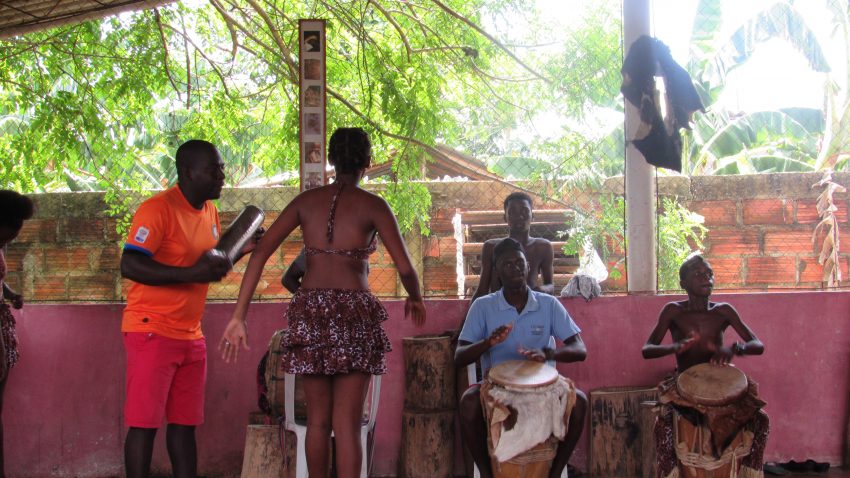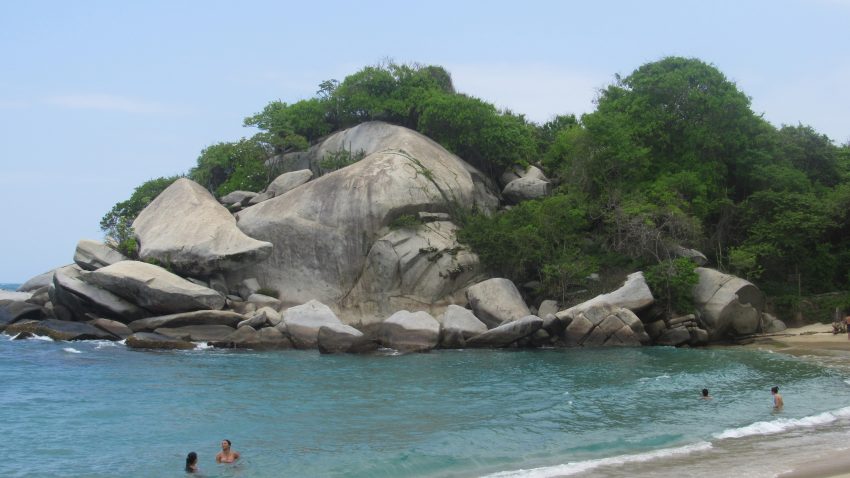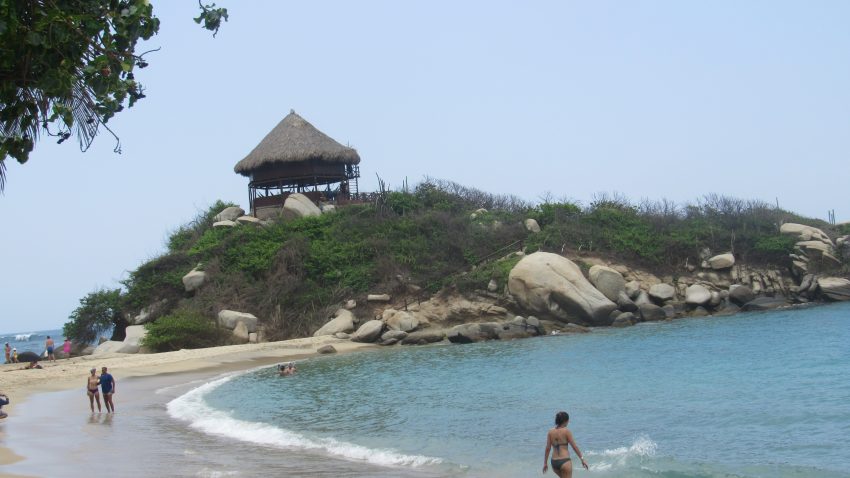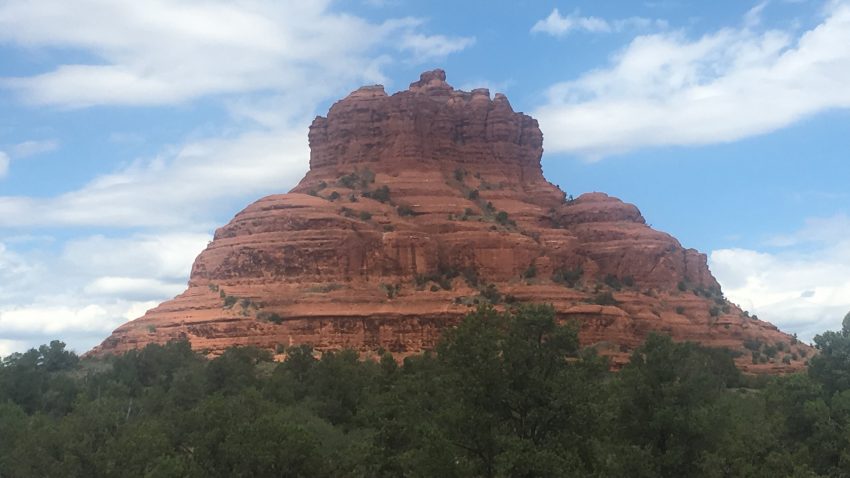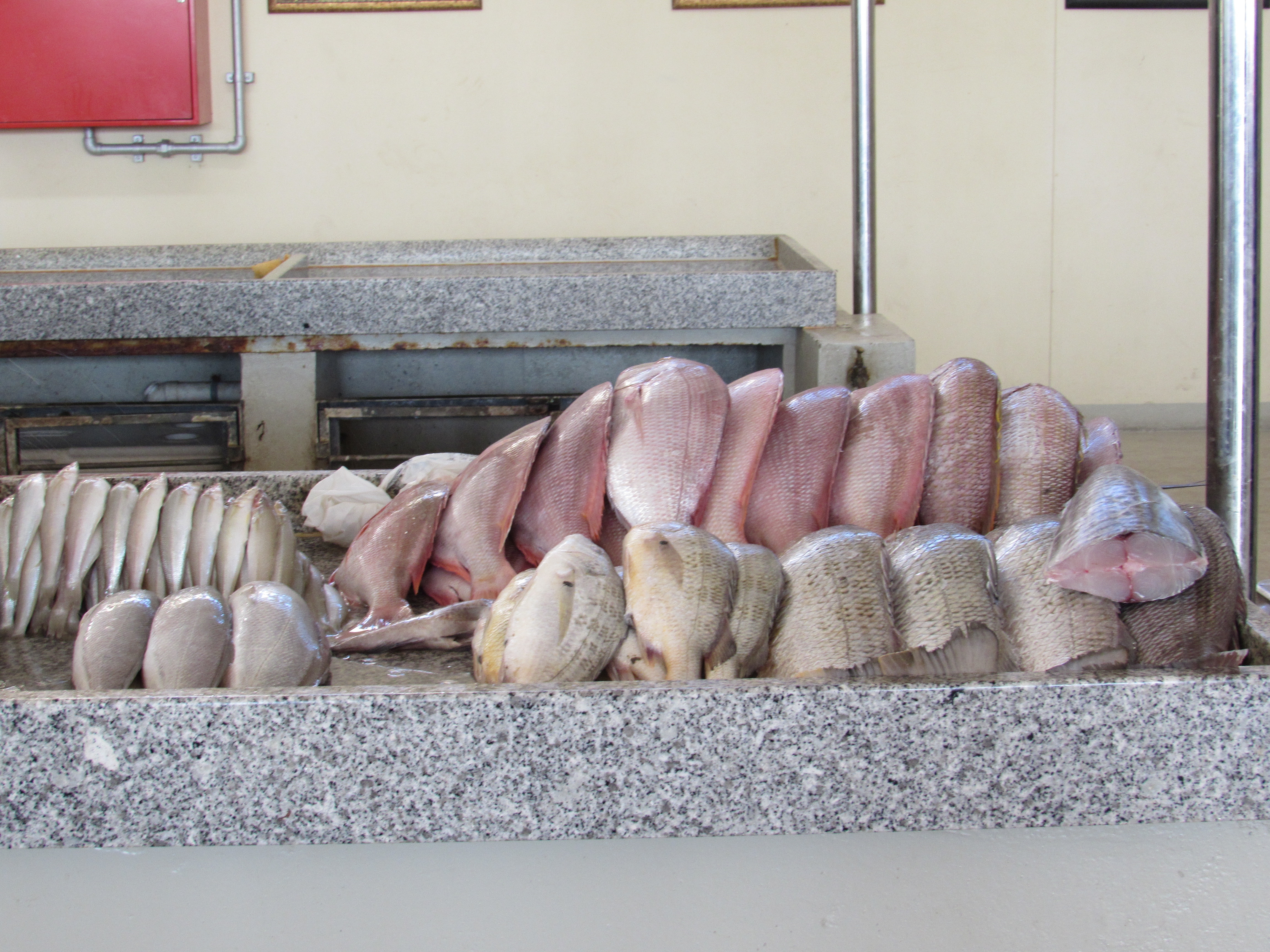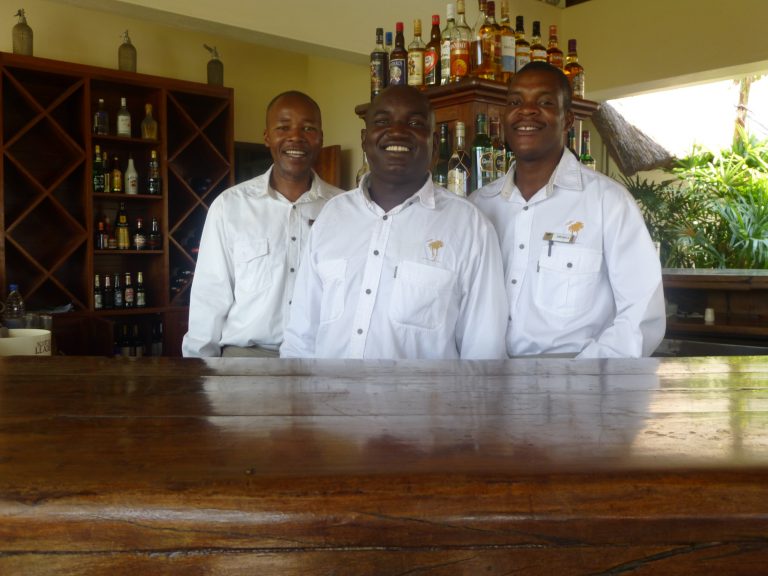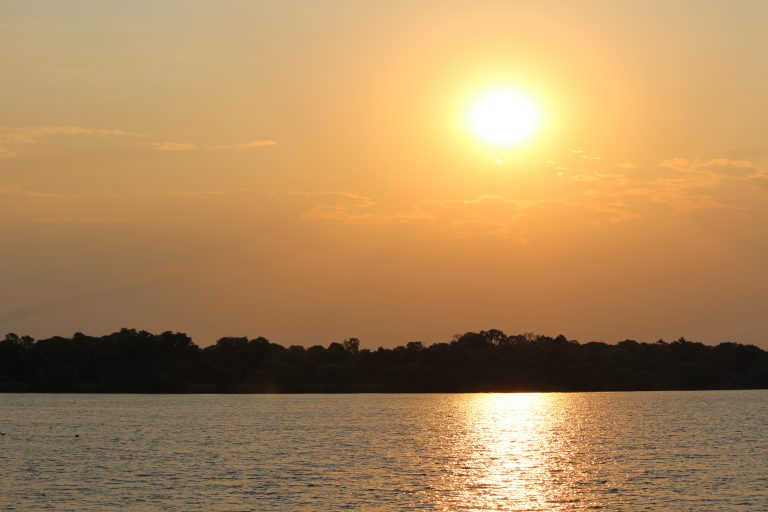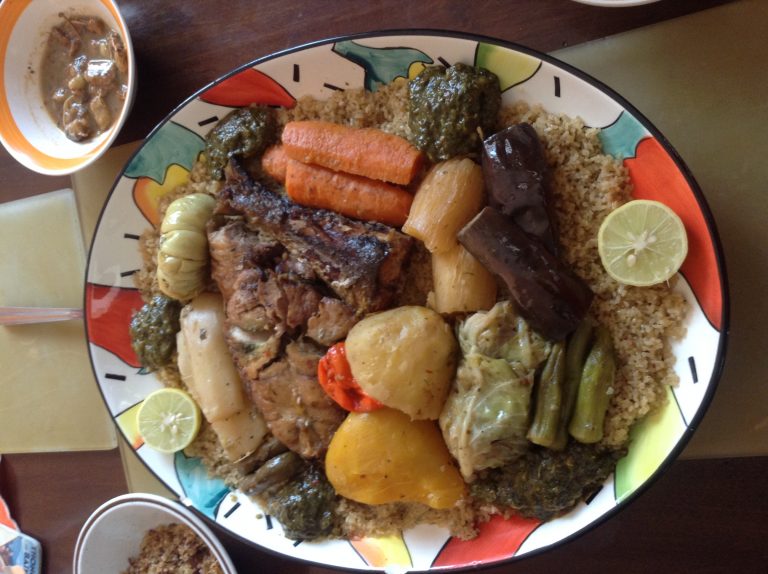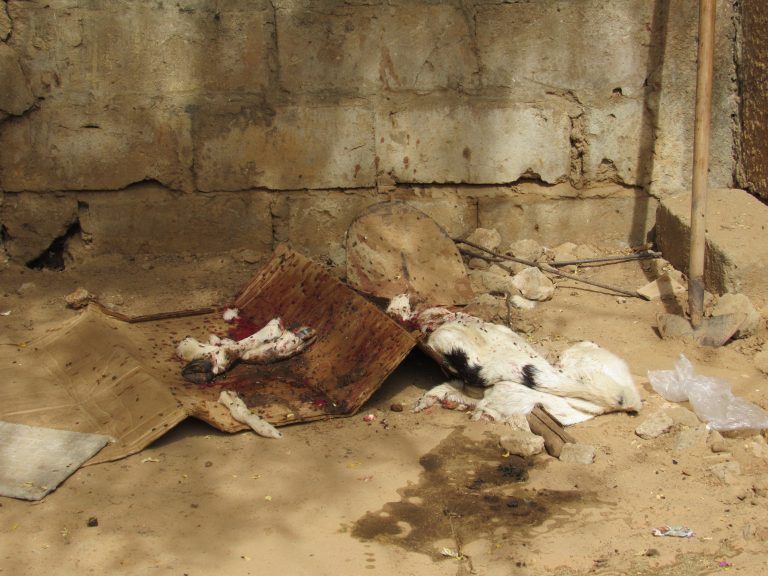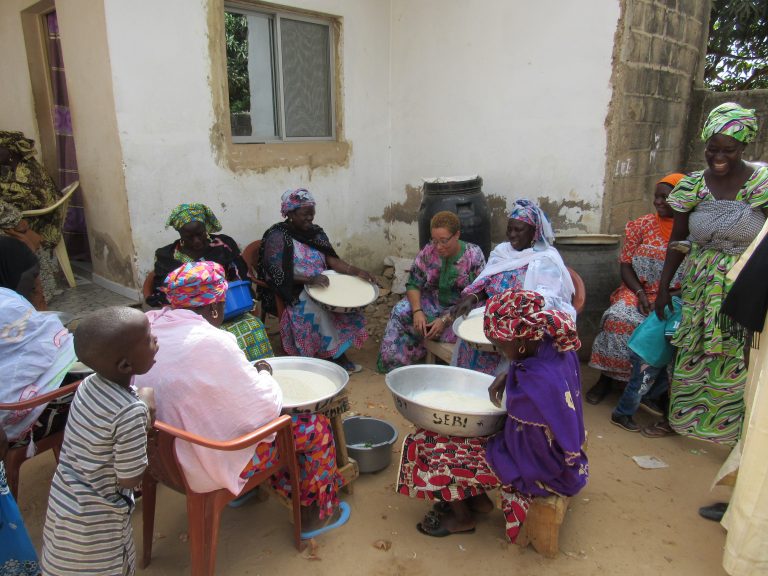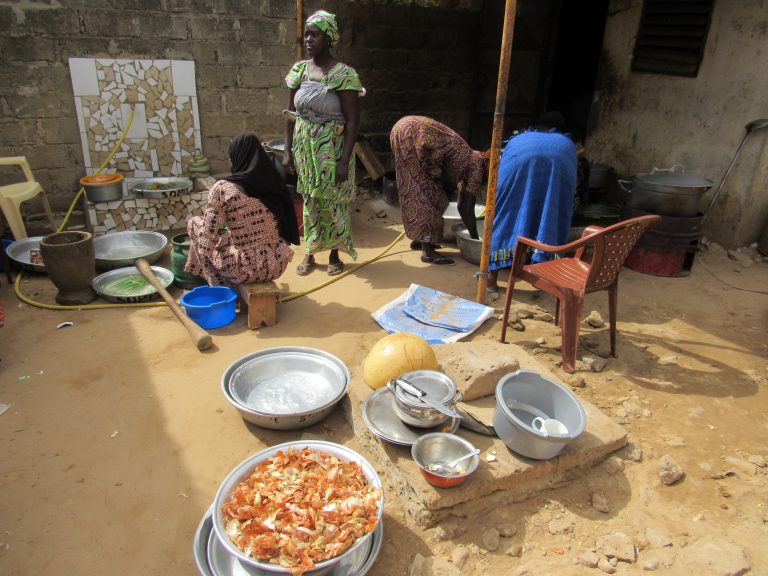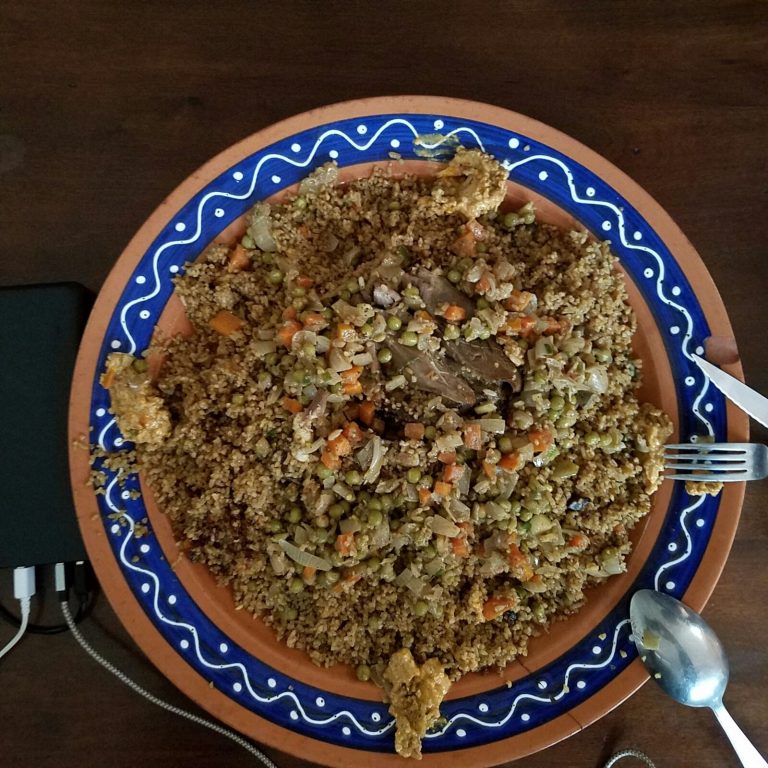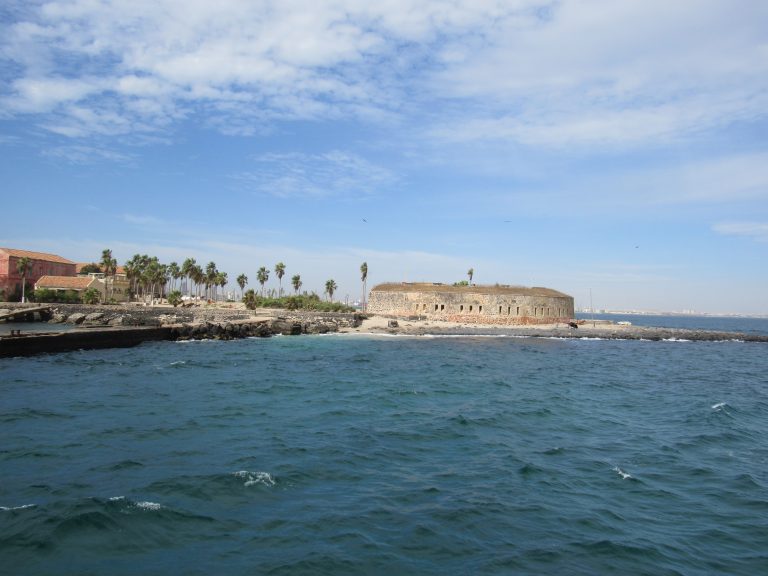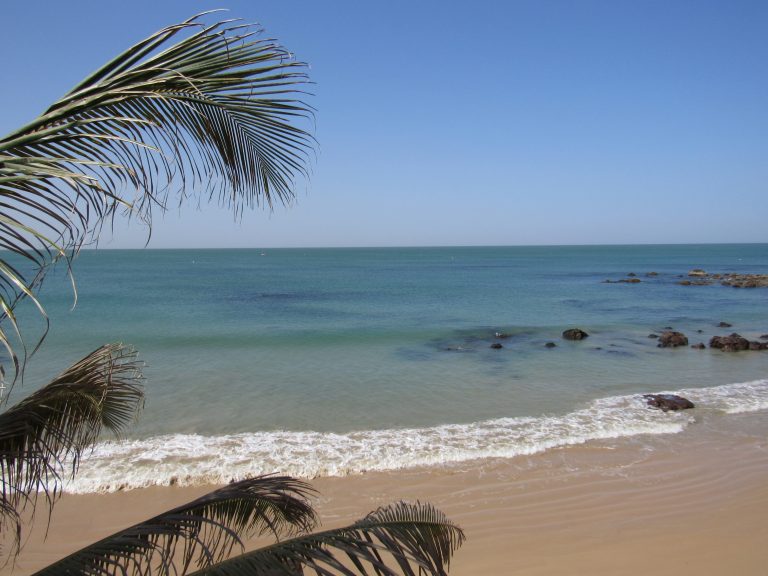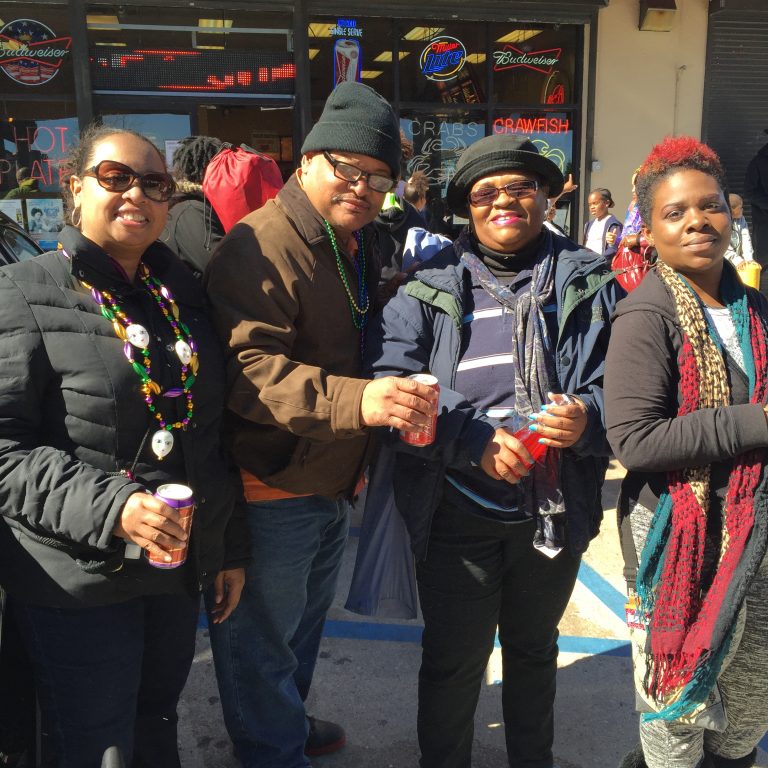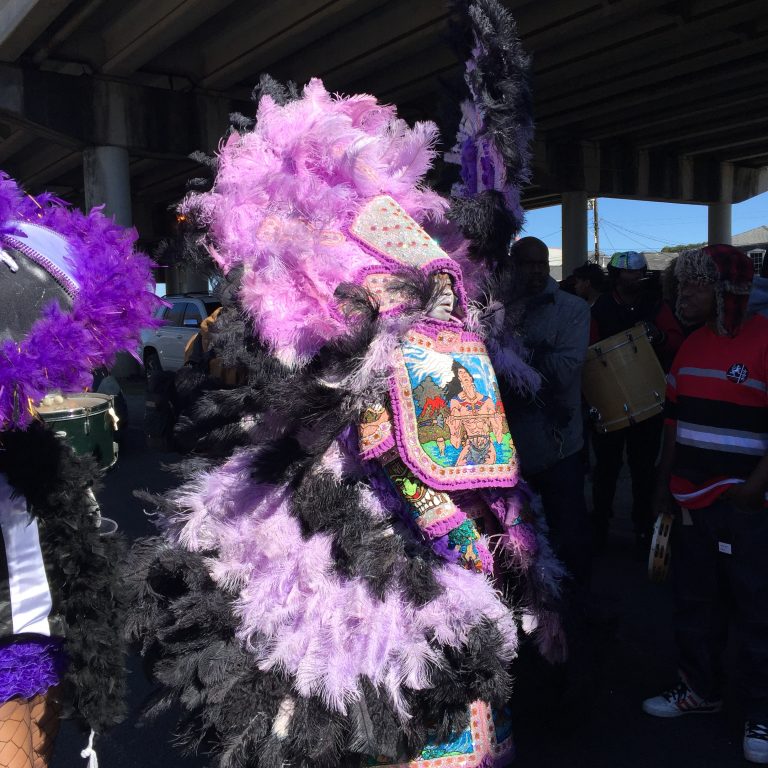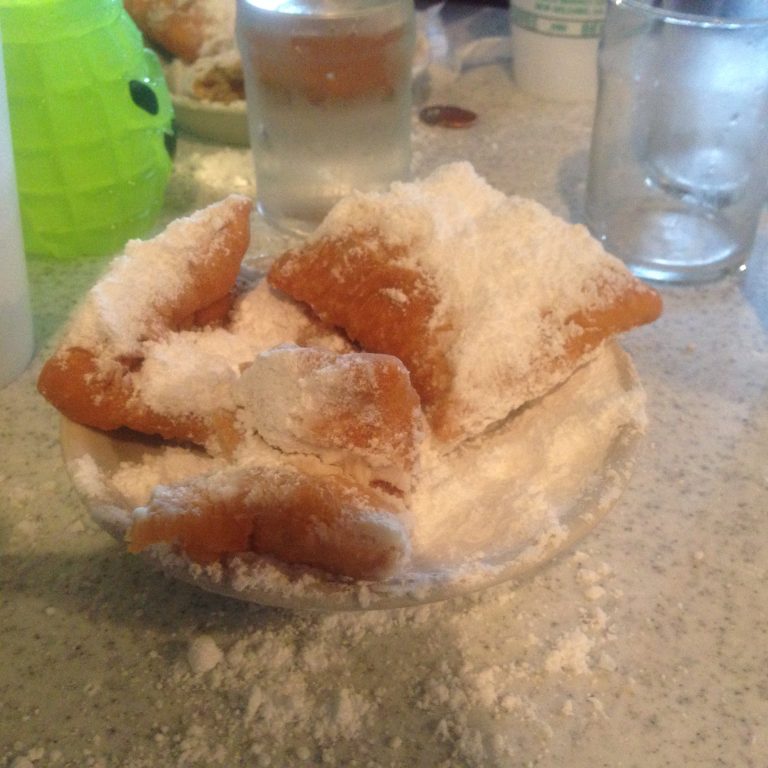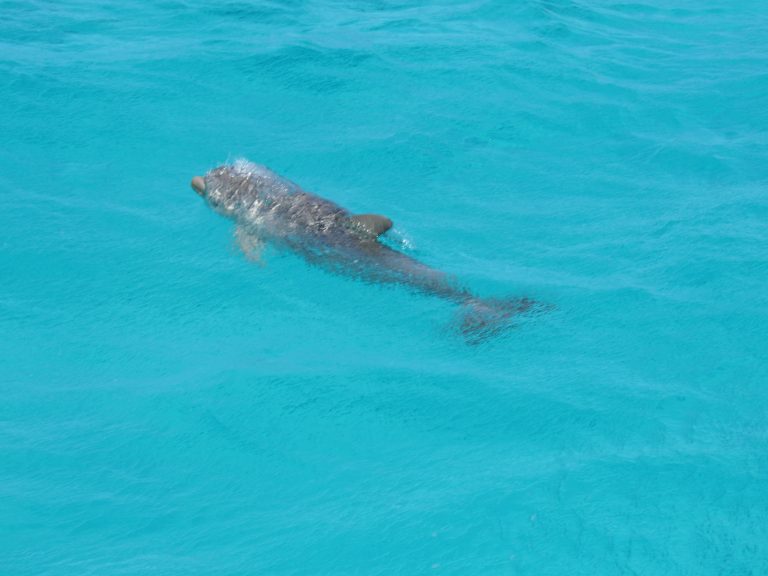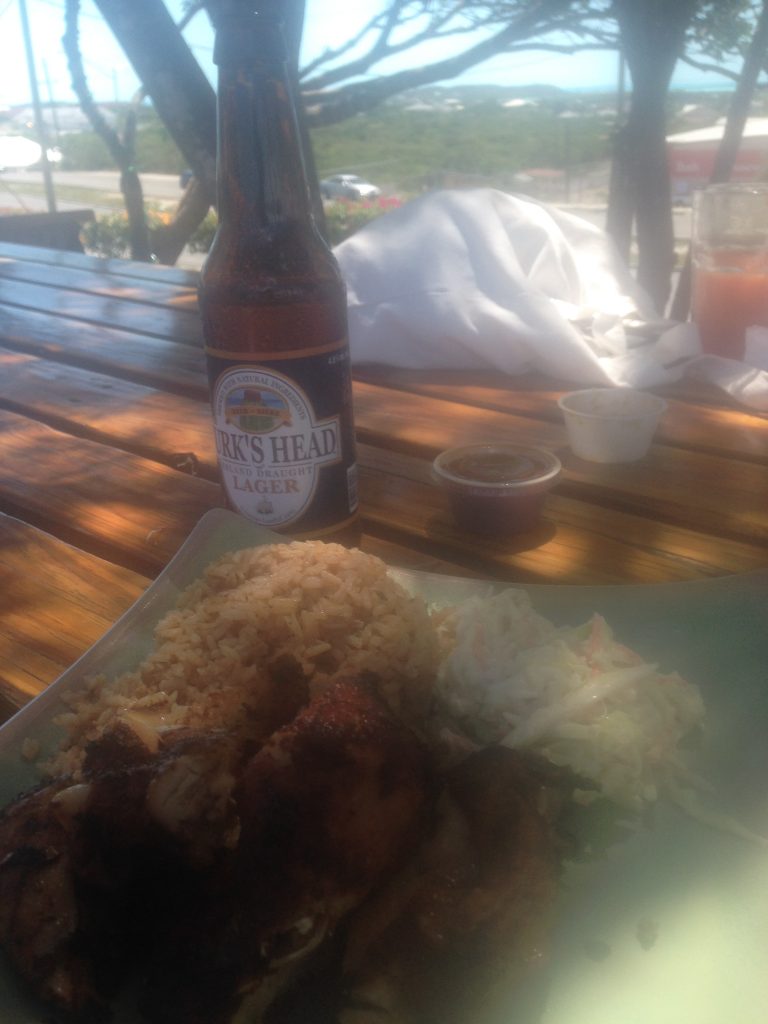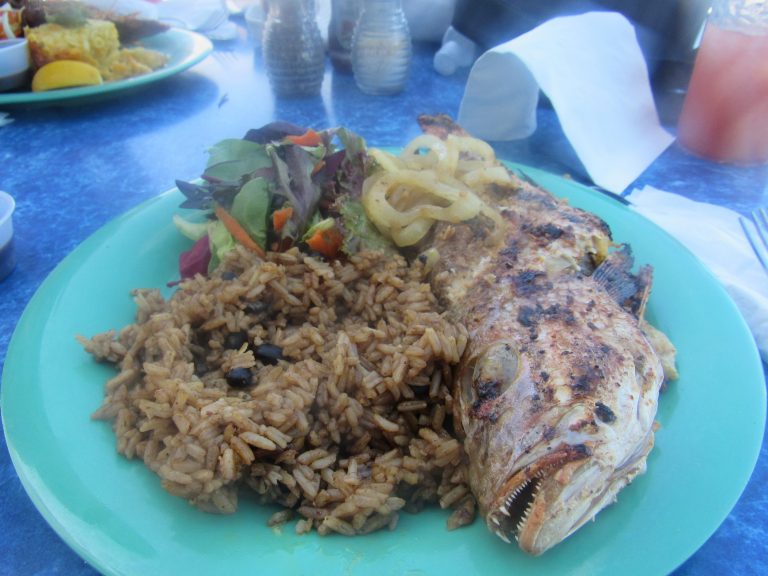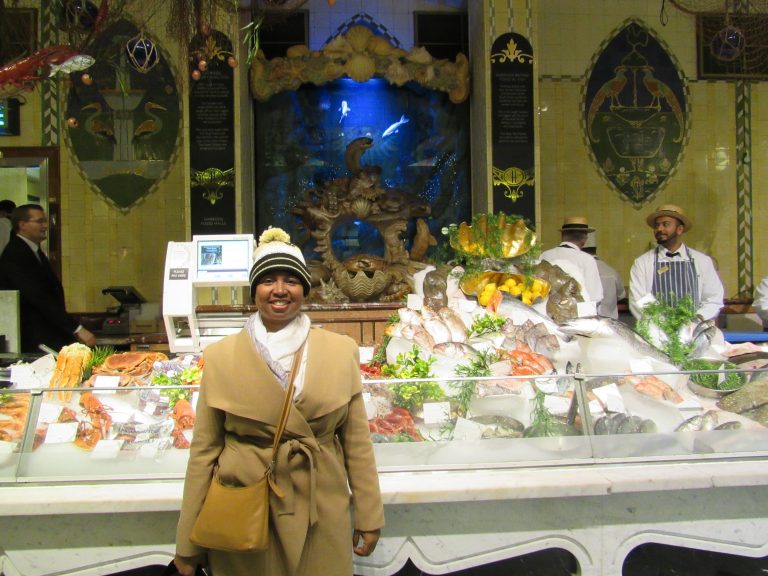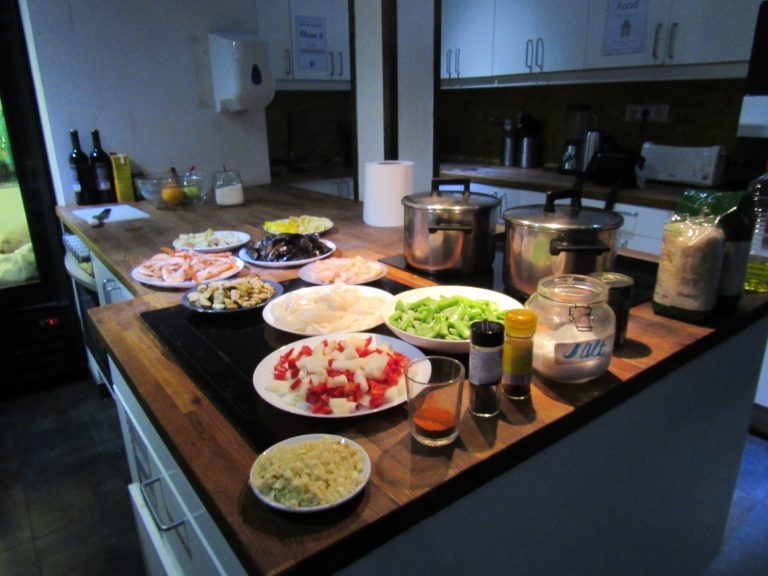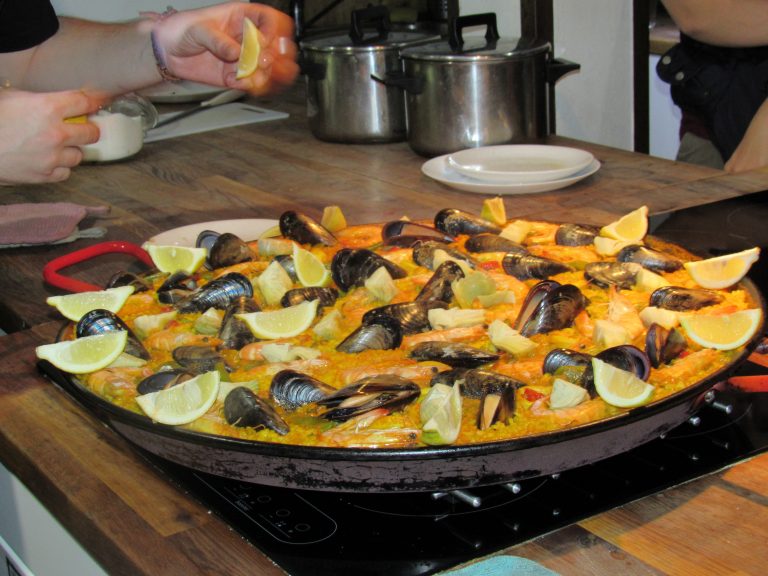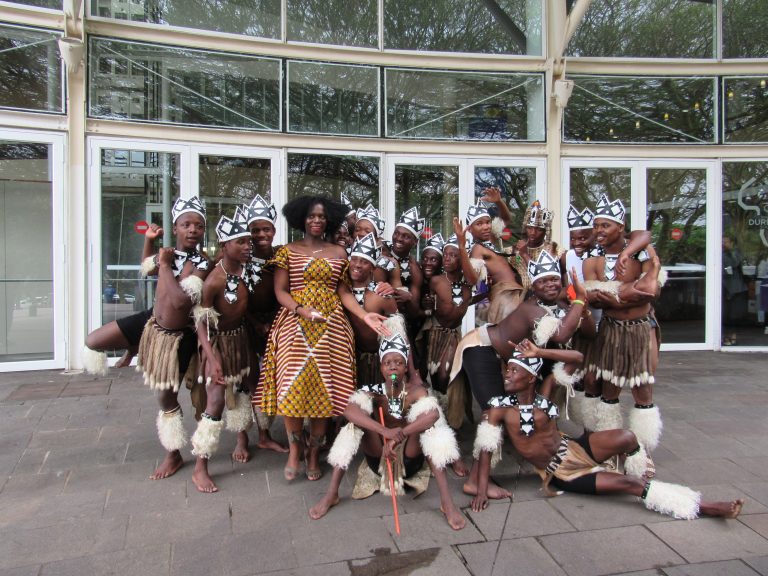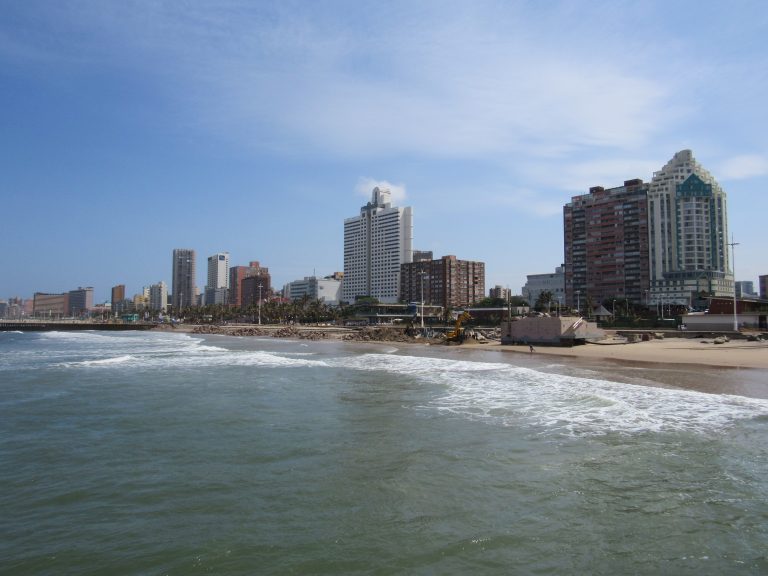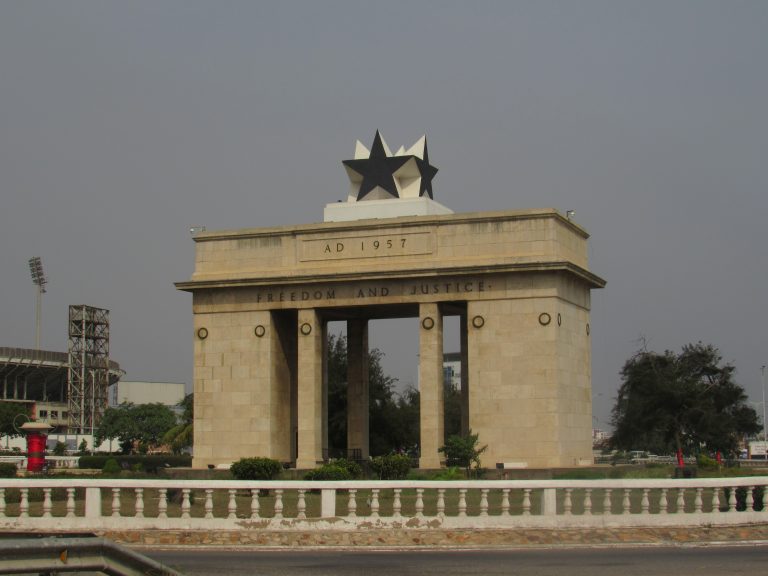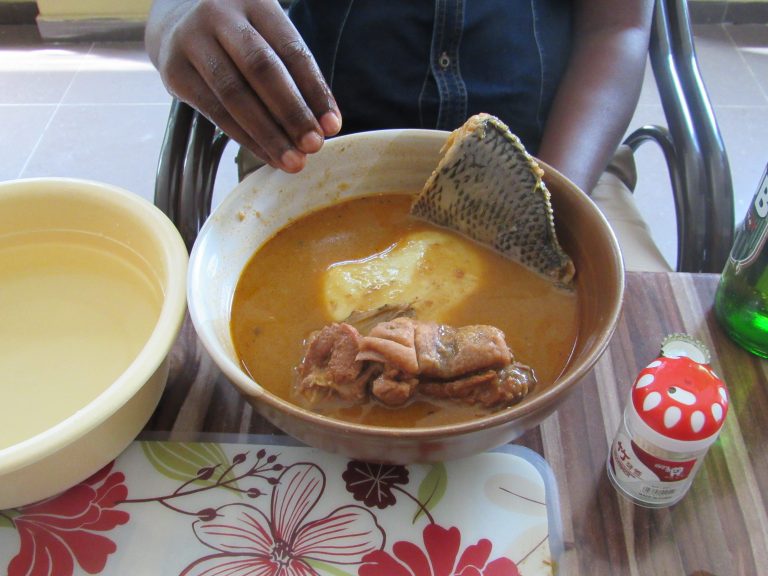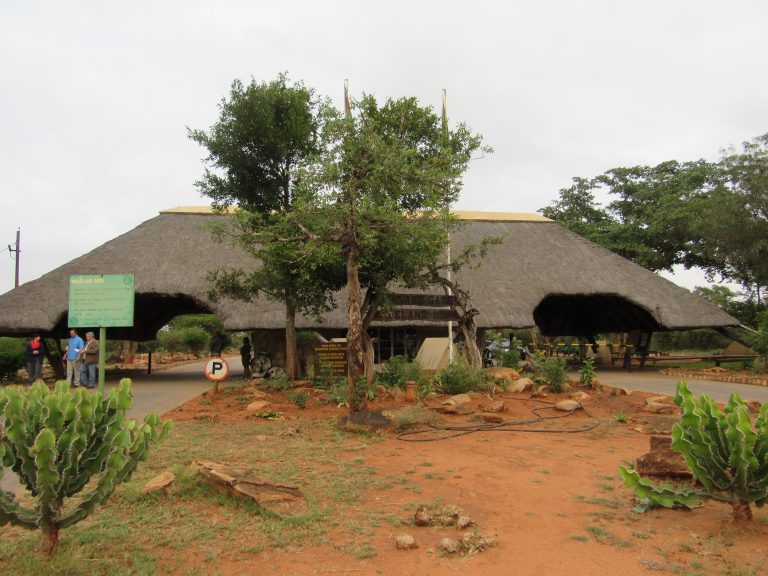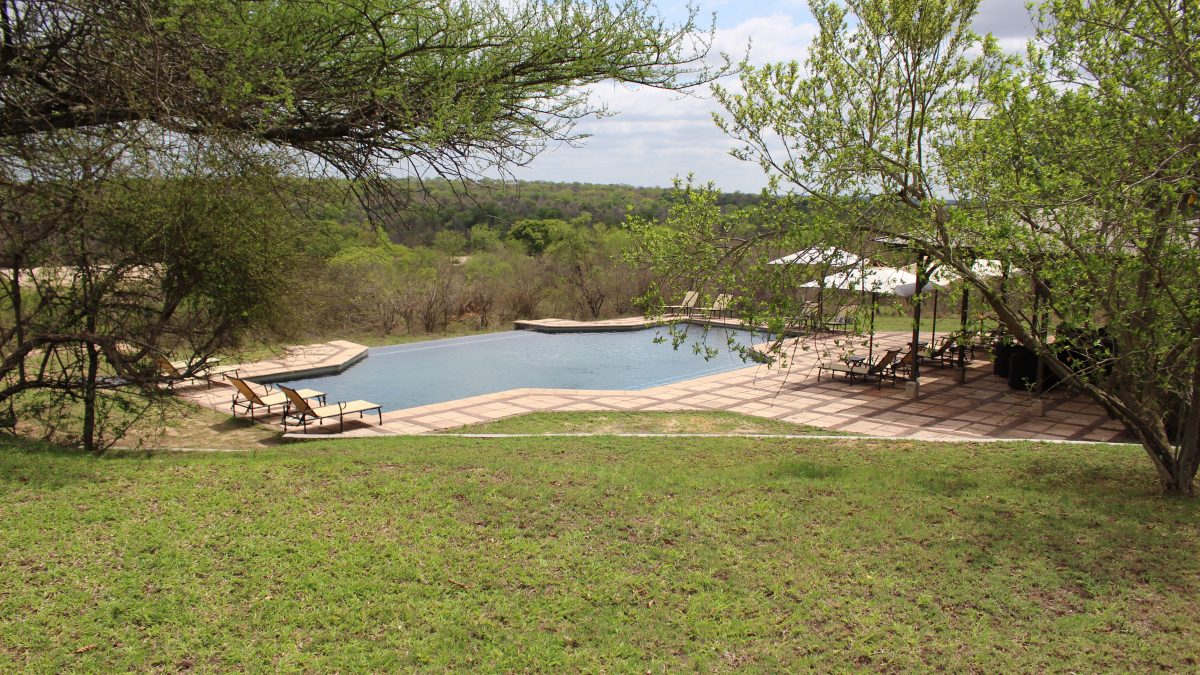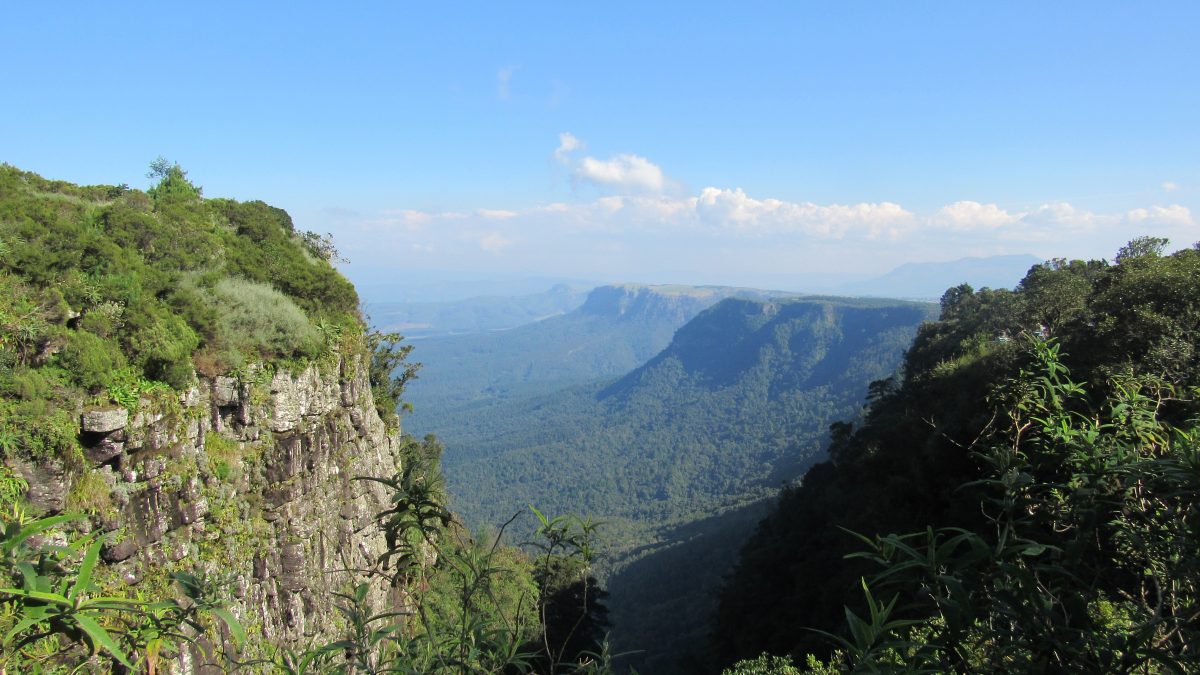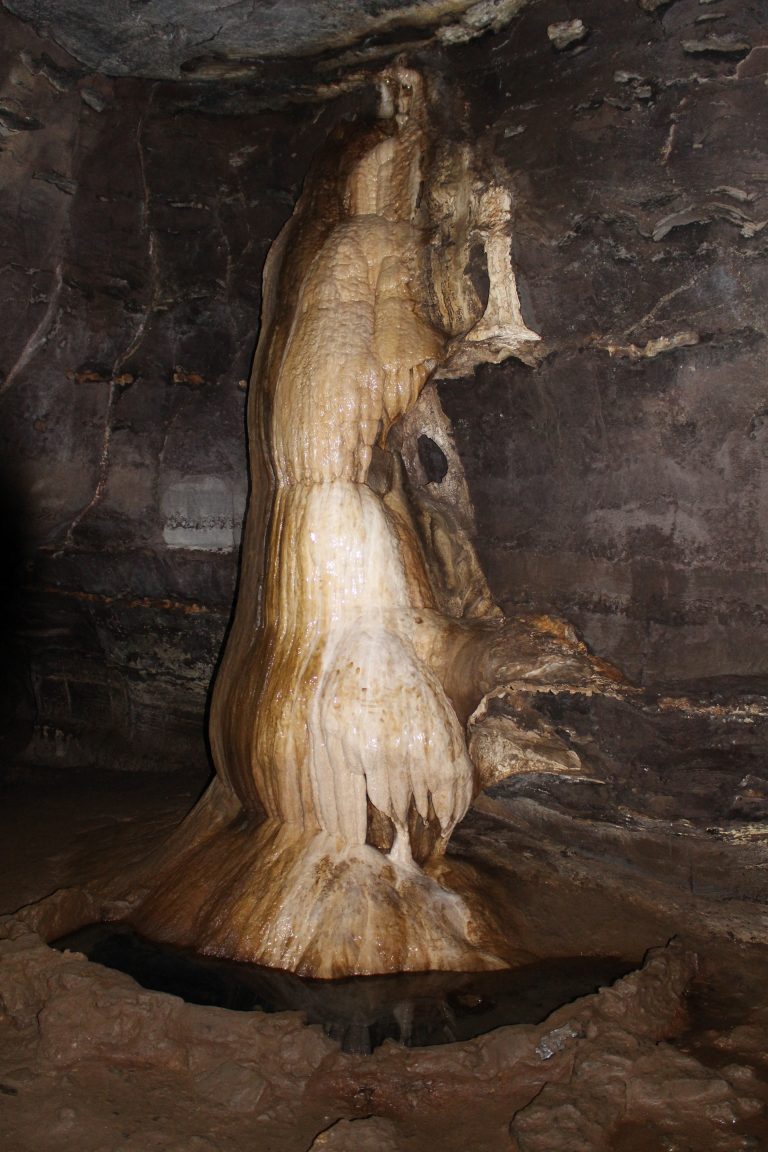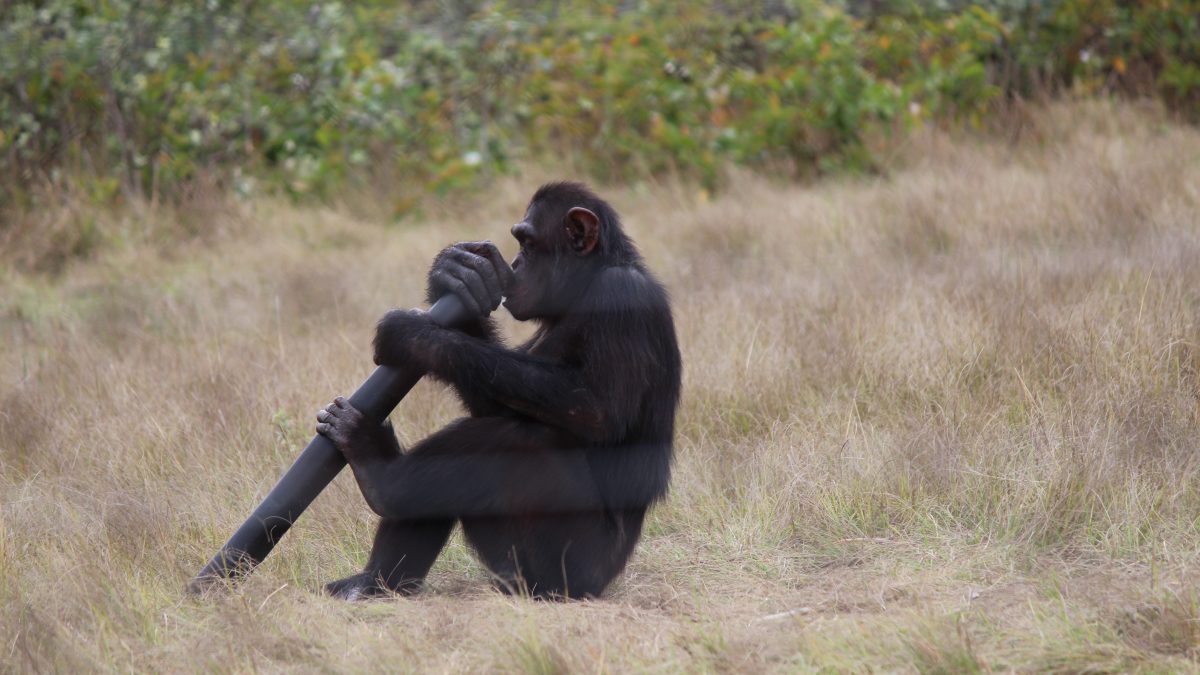The post Kigali, Rwanda: 1000 Hills Liquor Distillery & Bistro first appeared on The Travel Sista.
]]>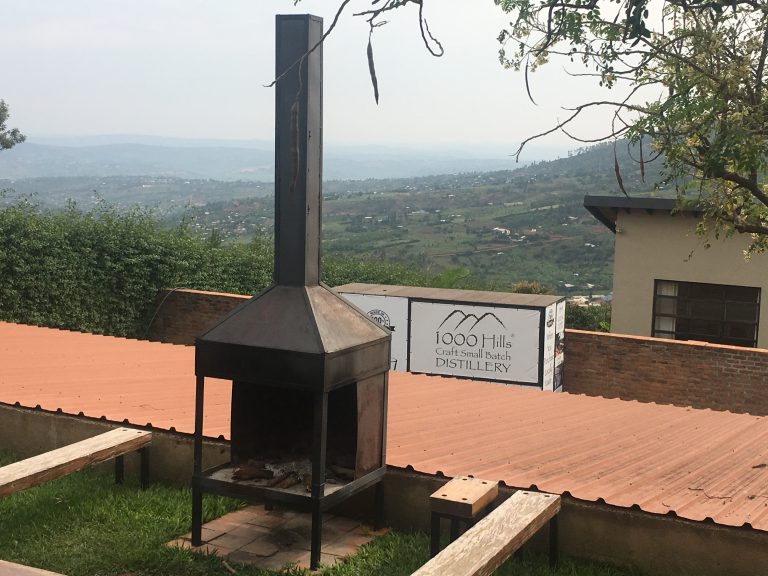 My tour was conducted by the managing director, Andrew Herweg, who was very knowledgeable and enthusiastic about the operation. He started with an overview of the distillery’s founding and guiding principles, then explained the machinery, the distillation process, and the current and future planned products.
My tour was conducted by the managing director, Andrew Herweg, who was very knowledgeable and enthusiastic about the operation. He started with an overview of the distillery’s founding and guiding principles, then explained the machinery, the distillation process, and the current and future planned products.
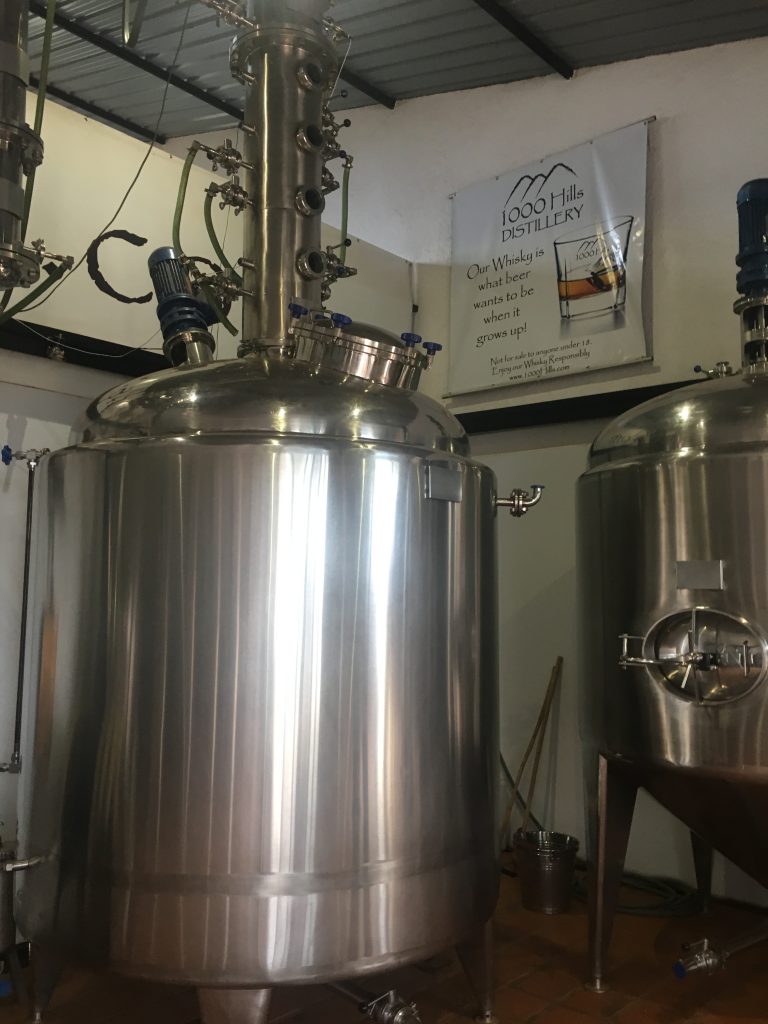 I was especially impressed with their social impact and eco-friendly focus. From start to finish, they mesh their business operation with green principles and community engagement. They use harvested rainwater which undergoes a 15-stage filtration process. Their sugar cane is sourced from a local village, supporting nearby micro and small businesses. The by-products created during the distillation process are supplied to the Rwandan government and local communities to make mosquito repellent, fertilizer and other farming products. And the food served in their Bistro is sourced from local farmers.
I was especially impressed with their social impact and eco-friendly focus. From start to finish, they mesh their business operation with green principles and community engagement. They use harvested rainwater which undergoes a 15-stage filtration process. Their sugar cane is sourced from a local village, supporting nearby micro and small businesses. The by-products created during the distillation process are supplied to the Rwandan government and local communities to make mosquito repellent, fertilizer and other farming products. And the food served in their Bistro is sourced from local farmers.
After the tour, it was time to taste the final product. I tasted each of their five triple distilled liquors: London Dry Gin, Vodka, Coffee Liquor, 3-year aged Malt Whiskey, and Light Spiced Rum. Not surprisingly, my favorite was the Coffee Liquor, which was smooth with the perfect mix of coffee and rum (I’m typically not a whiskey drinker, but surprisingly it was my second favorite). Coffee is a major crop in Rwanda, so of course, their coffee beans are sourced from a local women’s coffee cooperative.
After the tasting, I ate lunch at the Bistro – chicken tacos served with salad and fries and one of their signature drinks, the Singapore Sling made with 1000 Hills Dry Gin. Everything was fresh and tasty. The food menu is limited but there are several taco, satay and steak options. Though I didn’t try it, I’m told their signature steak, cooked on a hot rock, is one of Kigali’s most popular dishes. The drink menu is more extensive, with 16 signature cocktails all made with their liquors.
With stunning views, delicious cocktails, tasty meals and a socially conscious ethos, this place is not to be missed on a visit to Rwanda. To learn more about 1000 Hills, visit them on Facebook or Instagram. Tours and tastings can be booked online at the 1000 Hills website. They also sell their liquors, merchandise, and liquor-infused coffee beans on their website.
** I received a free tour and tasting in exchange for this review. All opinions are honest and my own.
Share ThisThe post Kigali, Rwanda: 1000 Hills Liquor Distillery & Bistro first appeared on The Travel Sista.
]]>The post My 2018 Year in Review first appeared on The Travel Sista.
]]>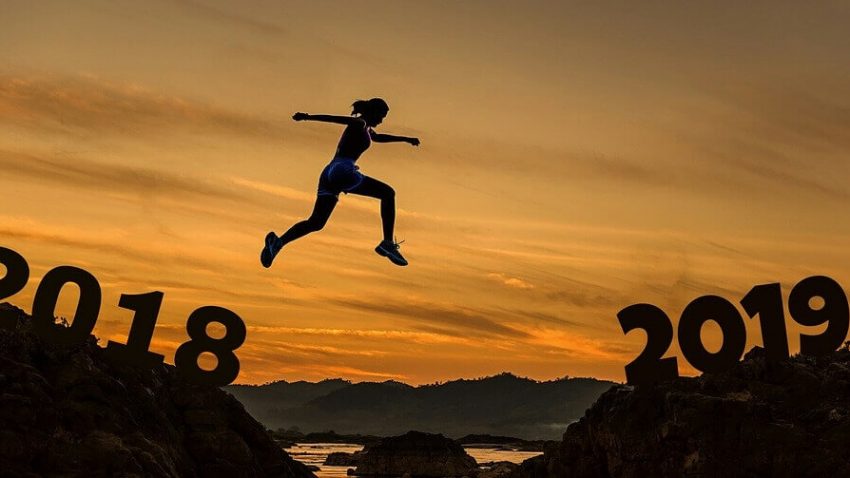
Here we are — December 31, 2018. My how this year has flown by. I can’t believe that 2018 is about to come to a close. As typically happens at this time of the year, many of my Facebook friends are posting 2018 reflections and 2019 goals. One of my friends did something different — he posted a listed of all the airports he traveled through in 2018. Of course, that prompted me to do the same (and made it easy for me to reflect on my year in travel).
My 2018 Airports
JNB – MPM – VNX – DAR – ZNZ – JFK – FLL – CTG – MSY – PHX – DTW
I brought in 2018 in the same place I will bring in 2019 – Johannesburg, South Africa – which is easily one of my favorite places on the planet. The creative vibe and energy here just can’t be beat. I’m a January birthday baby and if you didn’t know, I celebrate all month. I also love beaches, so of course, the celebration involved multiple beaches. My birthday celebration started off in Maputo, Mozambique. I checked into my guest house, dropped off my bags, and met up for dinner with some friends from one of my travel groups. We ended up at a house party with some new Mozambican and Angolan friends and had the time of our lives. As they say, what happens in Maputo, stays in Maputo.
Next, up was Vilanculos and the Bazaruto Archipelago. Vilanculos is a coastal town in southern Mozambique, known for its beautiful beaches, water sports, and snorkeling/diving opportunities. Vilanculos is also the gateway to the Bazaruto Archipelago, a chain of six islands off the Mozambican coast. The beaches and snorkeling there were superb.
I finished off my month-long solo birthday celebration in Dar es Salaam, Tanzania and my dream location, Zanzibar. I spent my actual birthday, January 16th, on a secluded beach in Paje. That evening, I met my tour guides for dinner at the Rock restaurant, which is famous because it sits in the middle of the Indian Ocean. It was high tide when we arrived and we had to take a small boat to get to the restaurant. It was low tide by the time we left and we were able to walk back to the beach. Talk about a cool experience! I returned home at the end of January and settled back into the real life. (sigh)
After a 2.5-month travel break, next up was Louisiana for the New Orleans Jazz Festival. I’m always happy to visit family and eat too much good food there. But, the highlight was my Detroit home girl, Anita Baker, who closed out the show. She put on a great performance.
For Memorial Day, I went to Fort Lauderdale which was completely rained out. Luckily, I was only there for two days before moving on to Cartagena, Colombia. Colombia was a new country for me, not on my bucket list, but one which I thoroughly enjoyed. The first highlight was my visit to Palenque, the first free town in the Americas founded by escaped slaves. Located about 45 minutes from Cartagena, in the foothills of the Sierra Maria mountains, today Palenque is inhabited by the descendants of those slaves, who are proud of their heritage and retain many African customs. Their very existence is a testimony to the human spirit and resilience in the toughest of situations. The second highlight was Tayrona National Park and Cabo San Juan beach. It took six hours to get there, including three buses, a horseback ride through the jungle and short trek, but boy was it worth it. I spent a relaxing day on the beach and the lunch of fried fish, plantains, and coconut rice was the icing on the cake.
Over the summer, I returned to two states where I formerly resided: Arizona and my birth home of Michigan. In Phoenix, I was honored to see a family friend consecrated as Bishop and I visited with friends I hadn’t seen in a few years. Of course, I couldn’t leave Arizona without visiting Sedona, one of my favorite places in the state. The beauty and serenity there is unmatched. In Michigan, I celebrated the 20-year judicial anniversary of a judge I previously worked for. It was great to see former colleagues and friends.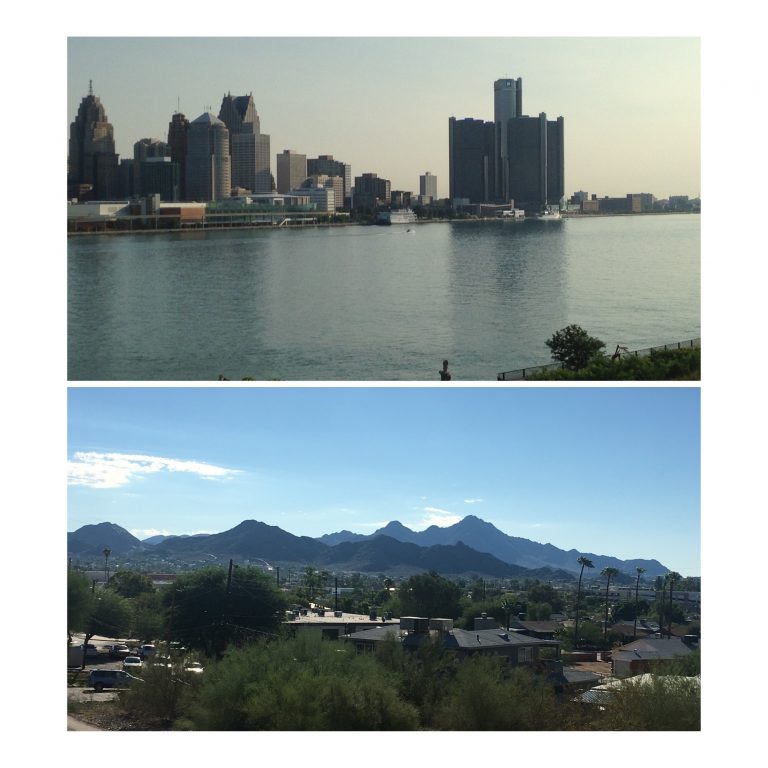
I’m ending the year back where I started – South Africa. This country has become my second home and I miss it every time I leave. But I’ve decided to do some venturing out in 2019, to explore other countries and finally make it Machu Picchu. I may see less of SA in 2019, but my heart will still be there.
Wishing you a Happy New Year and more travel adventures in 2019. Cheers!
Share ThisThe post My 2018 Year in Review first appeared on The Travel Sista.
]]>The post The Top 10 Things to Do in Mozambique first appeared on The Travel Sista.
]]>Mozambique is a country in southeast Africa, bordered by Tanzania, Malawi, Zambia, Zimbabwe, Swaziland and South Africa. Its capital and largest city is Maputo, which is inhabited by nearly 1.2 million people. Like nearly all African countries, Mozambique is a former European colony, which gained independence from Portugal in 1975 after nearly 500 years of colonization. Sadly, its tourism industry sharply declined after independence. It’s unfortunate because the country’s natural beauty, beaches, national parks, wildlife reserves, and cultural heritage provide excellent eco-tourism opportunities.
Mozambique enjoys a lengthy coastline fronting the Indian Ocean and it boasts some of southern Africa’s best beaches, renowned for their coral reefs and great surfing, diving and snorkeling opportunities. It also has some of the freshest seafood, which is abundant and cheap. Though not as popular as neighboring South Africa, more tourists are being lured to see what this Lusophone country has to offer. Here are my top 10 Things to Do in Maputo and beyond:
- Visit the FEIMA Arts and Crafts Market. If you’re looking for souvenirs, African art or just somewhere to chill for a few hours, FEIMA is your place. This outdoor market is located inside a relaxing urban park with an abundance of shade trees and tropical plants. Artisans sell batiks, paintings, fabric purses, clothing, shoes, wood carvings and more. There are also two outdoor restaurants on site which serve both western cuisine and traditional Mozambican dishes.
- Be inspired by local art and culture. Núcleo de Arte is an art cooperative, home to more than 100 sculptors, painters, and other artists. During daytime hours, you can meet the artists and watch them at work next door at Cafe Camissa. There are frequent exhibitions and many display pieces are for sale, so bring cash with you. Fundação Fernando Leite Couto, is a cultural center which promotes the country’s art, culture and literature. It’s often the site of live concerts, readings and art exhibitions. Centro Cultural Franco-Mocambicano (CCFM) is another cultural center which has frequent music and dance performances. Check their respective websites for event schedules.
- Shop at the Mercado Central. This market, located in a picturesque colonial building in the Baixa district, is the main shopping hub in Maputo. You can find fabric, clothing, fresh seafood, fruits and vegetables, and many household staples. Prices are negotiable, so don’t be afraid to bargain. But stay alert and beware of pickpockets.
- Visit a museum. Maputo has several modest, albeit unique museums. The Central Train Station is Maputo’s landmark building and a fabulous work of architectural design. It’s an operating train depot, which also houses a museum detailing the history of Mozambique’s railways and communication systems. Inside are several old steamer trains and other historical photos and artifacts. The National Art Museum has a small but respectable collection of Mozambican art, including several large canvases by world-renowned artist, Malangatana. The Natural History Museum (Museu de História Natural) has an interesting collection of stuffed animals and wooden carvings. The National Money Museum (Museu Nacional da Moeda) holds a collection of the many currencies that have circulated in Mozambique’s history; they include barter tokens, gold dust, and current-day bills. Lastly, the Iron House (Casa do Ferro), designed by Gustave Eiffel, architect of Paris’ Eiffel Tower, contains a small display of artifacts from some of Mozambique’s medieval cities and trading posts. The house was originally intended to be the Governor’s home, but because of the all-metal structure it was too hot to live in under Maputo’s tropical conditions. Luckily, now it’s air conditioned.
- Go on the Bairro Mafalala Walking Tour. This 2-hour walking tour takes visitors through the Mafalala bairro, Maputo’s oldest township or informal settlement. Mafalala lacks the affluence of other neighborhoods, but is a source of national pride and rich historical, political and cultural roots. The tour includes a stop at the house of the late Samora Machel, the Mozambican revolutionary and its first president post-independence, a visit with a local curandeiro (healer), and a traditional dance performance. This tour is a must for anyone interested in learning about Mozambique’s history and struggle for independence.
- Enjoy Mozambican music. Mozambican music has thrived since independence and there is no shortage of venues for music lovers. Each Thursday night, from 6:30 to 9:00 pm, a different local band plays live music at the Associação dos Musicos Moçambicanos. The crowd is young and mostly local (with a few expats and tourists tossed in), the vibe is laidback and fun, and the music a mix of hip hop, Afro beats, and reggae. For the jazz fans, the Africa Bar has live jazz on Thursday nights. Chez Rango, a lounge inside the Central Train Station, is the place to go for live jazz on Saturday nights. Nucleo de Arte has a DJ and live bands performing on Sunday evenings. In fact, most restaurants have DJs or live music performances on weekend nights.
- Eat fresh seafood. If you’re a seafood lover, Mozambique will not disappoint. Maputo’s Mercado do Peixe is the place to go for fresh seafood. From fish, prawns, and lobster to crab, clams and calamari plucked straight from the water, this place has it all. The market is housed in a new waterfront building where seafood is sold by the kilogram and cleaned upon request for an additional fee. If you don’t speak Portuguese, it pays to go with a local who can help you negotiate price. And if you don’t feel like cooking, your seafood and a variety of side dishes can be cooked on site for you. The market’s waterfront patio is the perfect place to sit with friends and eat, drink and enjoy the views. Service can be slow, so don’t go there famished, but it’s a fun time, especially on Sundays. If long waits aren’t your thing, several waterfront restaurants can meet your desire for great seafood, including Campo di Mare, Sagres, Docks, and the Maputo Waterfront Restaurant.
- Delight in the beaches, water sports, and marine life. Mozambique is known for its beaches, but for the best ones you’ll have to leave Maputo. Xai Xai beach is popular with tourists and closet to Maputo at only two hours away. A coral reef running parallel to the shore offers good snorkeling and protects the beach from strong waves. The nearby Bilene beach also offers calm waters and relaxed vibes. Jet skiing, scuba diving, sports fishing, sailing and canoeing are among the many activities enjoyed there. Ponta d’Ouro is known for its great beach, party atmosphere, dolphins, offshore diving, and deep-sea fishing. Tofo is another popular beach town, located about 4 hours north of Maputo and known for its reefs and excellent diving and snorkeling. It is one of the best places to see manta rays, sea turtles, and whale sharks. Vilanculos, accessible from Maputo by a one-hour flight or eight-hour bus ride, is the Mozambican water sports capital. Kite surfing, horseback riding and traditional dhow boat safaris are also popular there. Vilanculos is the gateway to the Bazaruto Archipelago, known for its fabulous beaches.
- Explore the islands. Inhaca island is a beautiful oasis located just 30 miles across the bay from Maputo. It’s suitable for a day trip or weekend getaway. Inhaca’s Santa Maria beach is popular with locals and tourists wanting to enjoy its soft sand and clear waters. Catembe island is located on the southern side of Maputo Bay, about 15 minutes from Maputo by ferry. Though not as nice or as popular as Inhaca, it also offers great views of the Maputo skyline. The ferries to Inhaca and Catembe leave from ferry ports in downtown Maputo. For those willing to explore Mozambique’s northern reaches, numerous islands await you. The Bazaruto Archipelago is comprised of five islands: Bazaruto, Santa Carolina also known as Paradise Island, Benguerra, Margaruque and Bangue. The Bazaruto Archipelago is Mozambique’s only underwater national park and there are several dive sites around the islands. Even further north are the Quirimbas islands, an unspoiled chain of 32 islands, known for its coral reefs, white sandy beaches, and crystal blue waters inhabited by dolphins, whales and endangered dugongs (sea cows).
- Search for wildlife on safari. The Maputo Special Reserve is located about 60 miles southeast of Maputo and includes 350 African elephants, birds, zebra, antelope, crocodiles, hippos, small bucks, bushpigs, baboons, and unique plant life. There are also marshes and two rivers inside the reserve, which are home to a variety of fish life. Gorongosa National Park, in central Mozambique, is home to lions, elephants, buffalo, zebras, bucks, hippos and crocodiles, as well as more than 400 species of birds. Its conservation programs are supported with tourist dollars. Niassa Reserve, in northern Mozambique, is home to the endangered African wild dog, elephant, sable antelope, buffalo, wildebeest, zebra and many species of birds. This protected area is twice the size of South Africa’s Kruger Park and boasts stunning natural scenery. Meculas Mountain (4,728 feet high) is located inside the reserve.
The post The Top 10 Things to Do in Mozambique first appeared on The Travel Sista.
]]>The post Mozambique: A Day at the Maputo Fish Market first appeared on The Travel Sista.
]]>As a seafood lover, I’d heard about Mozambique’s great seafood and was excited to see what it had to offer. It didn’t disappoint. I ate my fair share of fish, prawns and crab, both grilled and cooked in curry, garlic and peri peri sauce. But my favorite seafood experience was at the Mercado do Peixe (Maputo Fish Market).
In Maputo, Sunday is the favorite day to relax and socialize with family and friends at the Fish Market, a lively waterfront attraction popular with locals and tourists alike. The market is located in a newer seaside building where local vendors sell fresh fish, lobster, prawns, calamari, crab, clams and more, pulled straight from the waters surrounding Mozambique. Seafood is sold by the kilogram and can also be cleaned on request. Prices are definitely negotiable and affordable (our group of five paid the equivalent of $55 USD for one kilogram each of clams, calamari, and prawns, two whole fish, and one crab for me).
Opposite from the market is a waterfront patio with umbrella-covered tables and seating. Several restaurants there will cook your seafood for an additional fee (approximately 150-180 Meticais per kilogram [the equivalent of $3.00 USD], cash only). They also offer a number of accompaniments, including salad, rice, and fries, as well as water, sodas and alcoholic beverages. The service is slow, but the end result is delicious.
To say this seafood was fresh would be an understatement. As you can see by the smile on my face, I ate well and left happy.
Have you been to the Maputo Fish Market? What did you enjoy the most? Share your comments below.
Share ThisThe post Mozambique: A Day at the Maputo Fish Market first appeared on The Travel Sista.
]]>The post Why I’m Attending TBEX Zimbabwe and Why You Should Too first appeared on The Travel Sista.
]]>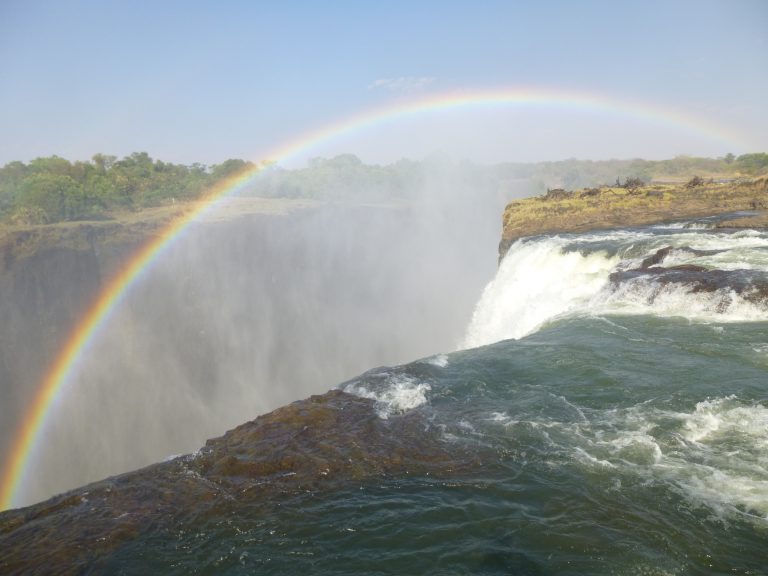
Travel Blog Exchange (TBEX) is the world’s largest gathering of travel bloggers, writers, new media content creators, and travel industry professionals. Each year, TBEX partners with host destinations in North America, Europe and Asia and brings together the travel community to learn, network and do business. At this year’s North American conference, TBEX announced that it would make its first foray into Africa. TBEX Africa will be held in late July 2018 in Harare, Zimabawe, hosted by the Zimbabwe Tourism Authority (ZTA).
Needless to say, as an avid traveler and lover of the African continent, I was thrilled at the announcement. Sadly, my excitement was not shared by all. Almost immediately there was a barrage of complaints by several bloggers who believed that TBEX’s decision to partner with the ZTA was unethical and irresponsible due to Zimbabwe’s history of human rights violations and corruption. In their opinion, TBEX collaborating with the ZTA is akin to aiding Zimbabwe’s oppressive regime. One even suggested that conference attendees could be at risk since their names and information would be shared with the government. To fully understand the controversy surrounding Zimbabwe, and why I disagree with the TBEX Africa detractors, some historical context is in order.
ZIMBABWE’S CONTENTIOUS AND COMPLICATED POLITICAL HISTORY
Zimbabwe is a landlocked country in southern Africa, bordered by South Africa to the south, Botswana to the west and southwest, Zambia to the northwest, and Mozambique to the east and northeast. Harare is the capital and largest city. Like most African countries, Zimbabwe has a colonial past.
In 1890, white English and Boer colonialists entered Rhodesia (as Zimbabwe was named before independence) and seized land and cattle belonging to the indigenous black population. Within 30 years, the 3% white minority controlled 75% of the economically viable land, while the 97% black majority resided on crowded reserves largely comprised of unfertile land. The land imbalance led to several ensuing wars which lasted off and on for nearly 100 years.
In 1980, the United Kingdom formally granted independence to Zimbabwe. As a part of the negotiated deal, the British and American governments made commitments to assist the Zimbabwean government financially with land reform efforts, which under the new constitution would take place in a willing seller, willing buyer context. That same year, Robert Mugabe was elected as Zimbabwe’s first prime minister and he eventually became president in 1987. Mugabe has remained in power for 30 years.
In 2000, disgruntled with the pace of land reform efforts and disputes over pledged funds, Mugabe’s government passed a Land Acquisition Act for compulsory acquisition without compensation. Landless blacks began to invade farms and seize white-owned land, with no reprisal by the government. Tapiwa Mabaye, Land Reform in Zimbabwe
In 2001, the United States began imposing targeted financial and travel sanctions on Zimbabwe’s government, as well as selected government officials and financial institutions. The sanctions have remained in place and were most recently renewed by President Barack Obama. U.S. Department of State, Bureau of African Affairs Fact Sheet
HUMAN RIGHTS VIOLATIONS AND THE EFFICACY OF SANCTIONS
There have been widespread reports of human rights violations in Zimbabwe. According to Human Rights Watch, police use excessive force to crush dissent and violate the basic rights of citizens, journalists, and government opponents. Amnesty International’s 2016/2017 report outlines numerous human rights violations committed by Mugabe’s Zimbabwe African National Union – Patriotic Front (ZANU-PF) party , including harassment, intimidation, assaults, arrests, protest bans, abductions, and torture.
To be sure, these oppressive actions are problematic and incompatible with the democratic values the U.S. vows to hold dear. But in the height of hypocrisy, the U.S. government recently signed a $110 billion arms deal with Saudi Arabia, a country with a long and well-known history of similar human rights violations. As documented by Human Rights Watch, Saudi Arabia has engaged in unlawful airstrikes in Yemen, some of which may constitute war crimes; repressed pro-reform activists and peaceful dissidents, sentencing them to long prison terms; discriminates against women and girls in most aspects of daily living; and perpetrates systemic violations of due process and fair trial rights of adults and pubescent teens; and performs mass executions, including public beheadings. Similarly, the United Arab Emirates and China, both countries with longstanding and serious human rights problems, rank among the top 30 trade partners with the U.S.A. It’s difficult to understand, much less defend, such blatant double standards.
What is clear is that history has shown that sanctions and boycotts are largely ineffective in changing a form of government. Instead, boycotts and sanctions punish innocent people who are often the targets of oppressive regimes. Zimbabwe is no exception. In 2013, the ZANU-PF party admitted the unemployment rate was 60%, though by other estimates it’s as high as 95%. The World Bank estimates that 75% of the population lives in poverty and a majority survives on less than two dollars per day. Rather than cripple the Zimbabwe government, U.S. sanctions have further impoverished the Zimbabwean people and made them less likely or able to fight for regime change. Sanctions have also turned some into harsh critics of the United States.
MY FIRSTHAND EXPERIENCE
I was blessed to travel to Zimbabwe in 2013 and experience its beauty and splendor firsthand. I checked off a bucket list item at Victoria Falls (aka Mosi-Oa-Tunya Falls in the local Lozi language) and swam in the Devil’s Pool at the edge of the Falls. It was an exhilarating, once in a lifetime experience and probably my favorite travel adventure to date. I drank Zambezi beer while cruising on the Zambezi river at sunset and watched the blue sky transform into fiery bursts of orange and red like I’ve never seen. And I marveled as I watched warthogs freely graze outside my hotel room and saw a mother baboon groom her baby as I walked past on the sidewalk.
But I also saw how boycotts against the Zimbabwe government have decimated the tourist industry. The first sign was at my hotel, where I never saw more than five people at the pool, restaurant and bar. As I typically do when I travel, I chatted up with the hotel staff about their life in Zimbabwe and the tourism industry there. My waiter shared that he regularly works 12 to 14 hour shifts and walks 2.5 hours each way to and from work. On the day we talked, my $10 tip was the first he’d received that day. He mused that his life was not easy, but he considered himself lucky because at least he had a job unlike so many others. I also talked to several street vendors who shared their difficulty selling their wares and earning a living due to the lack of visitors. These are the real life consequences so often lost or ignored in political debates.
In the case of Zimbabwe, boycotts also have other collateral effects. Zimbabwe is one of Africa’s most hardest hit countries when it comes to illegal poaching of big game, as some locals resort to poaching in order to feed their families. The absence of tourists also means less funds for wildlife conservation and more reliance on legal big game hunting to make up for the shortfall. In short, tourists provide security for Zimbabwe’s people and its abundant wildlife, because they deter poaching and hunting.
THE CASE FOR TBEX ZIMBABWE
Zimbabweans are warm, kind and proud people and they’ve paid a heavy price for the political chaos of the last 17 years. They deserve the opportunity to show off their country to conference attendees, and to also share their culture and heritage, as well as their tales of tribulation and triumph. They are my primary reason for attending and I will be there to support them.
Secondly, Africa has some remarkable bloggers (and aspiring bloggers) who rarely have the opportunity to attend TBEX in North America, Europe or Asia due to the time and expense involved in traveling. Having the conference in their backyard will afford them the opportunity to learn and network with other bloggers and industry professionals, and to gain exposure to a wider audience. In turn, the travel media community can become better informed about their countries and the complex issues they face. Ideally, it will lead to collaborations, both to promote the tourist attractions but also to brainstorm on the hard hitting issues presented by the situation in Zimbabwe and the continent as a whole.
Lastly, Zimbabwe is a beautiful country with an exhaustive list of attractions and activities. From waterfalls that span two countries to Chinhoyi Caves, ancient ruins, balancing rock formations, national game parks, bustling outdoor markets, and a modern capital city, there is something for everyone. And for the adventurous, thrill seeker types, there’s white water rafting, bungee jumping, ziplining, a bridge swing, a bridge slide and helicopter rides over the Falls.
Furthermore, because Zimbabwe, Zambia and Botswana share borders, it is relatively easy to visit three countries in one trip. In the past, visas were an impediment because each country required a separate visa, which was an added hassle and expense. However, the countries recently re-introduced the KAZA Uni-Visa, a 30-day joint visa which allows visitors to freely travel between Zimbabwe and Zambia and to take day trips to Botswana via the Kazungula border crossing, where the borders of Zimbabwe, Zambia, Botswana and Nambia meet in the middle of the Zambezi River. The cost is an affordable $50.
TBEX Africa will present the chance for not just Zimbabwe, but for the entire southern Africa region to display its magnificent and diverse people, cultures, landscapes, and tourist attractions. I’m excited for the region, as well as the conference attendees who’ve never been to the continent. They are in for a treat.
Do you plan to attend TBEX Africa? Why or why not? Share your comments below.
Share ThisThe post Why I’m Attending TBEX Zimbabwe and Why You Should Too first appeared on The Travel Sista.
]]>The post Senegalese Cuisine: Where Food and Culture Intersect first appeared on The Travel Sista.
]]>I arrived in Dakar around 2:00 am, and my hosts Phyllis and Eddy from Diasporic Soul were ready for me with dibi and rice to feed my tummy. Dibi, one of Senegal’s favorite street foods, is grilled lamb, cut into small pieces and usually served with grilled onions, mustard sauce and bread. We stayed up talking until after 5:00am and I got a firsthand taste of Senegalese teranga too (Teranga is a Wolof word meaning hospitality).
I woke up in early afternoon to the most amazing smell and learned that I would be treated to Senegal’s national dish, Thebu Jenn. Thebu Jenn is a flavorful fish and rice dish served with a variety of vegetables and it comes in white and red (tomato-based) variations. I had the white and it was heavenly. It was served with bissap sauce, made from hibiscus leaves with the consistency of creamed spinach, and xoon, the coveted crunchy rice from the bottom of the pot.
Over the next few days, I had Yassa Poulet and Poisson – fish and chicken versions of the popular dish made with onions, lemon juice and garlic and served with rice.
But the highlight was my attendance at a “ngente” or baby naming ceremony. It was a special day where family and friends gathered for a day of good food and celebration. After the baby girl was named, the men killed two sheep in the baby’s honor (I didn’t watch and only saw after it was done). Then the ladies all went to work preparing the meal. They cleaned the lamb, cut vegetables, and cleaned and cooked rice. It was fascinating to watch them work together and prepare a meal for 30+ people, all while dressed to the nines. The final product, Thebu Yapp, was the best meal I had during my time in Senegal.
Have you tasted Senegalese cuisine? What is your favorite dish? Share your comments below.
Share This
The post Senegalese Cuisine: Where Food and Culture Intersect first appeared on The Travel Sista.
]]>The post Senegal Travel Guide: Planning a Trip to Dakar first appeared on The Travel Sista.
]]>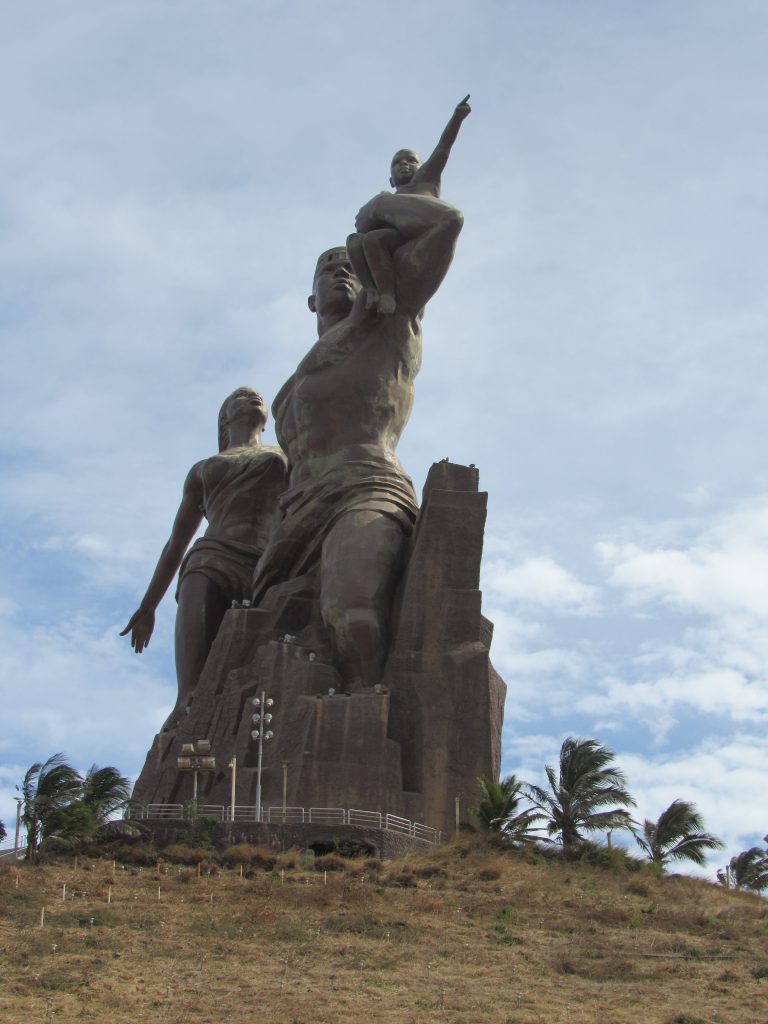
African Renaissance Monument
Senegal is a country in West Africa, which surrounds The Gambia on three sides and is bordered on the north by Mauritania, on the east by Mali, and on the south by Guinea and Guinea-Bissau. Dakar is the capital and largest city of Senegal, and it sits on the Cap-Vert peninsula, the westernmost point of Africa.
Although Senegal is a majority Muslim country, with more than 90% of the population practicing Islam, the vibe is vibrant and diverse. Culturally, the traditional/religious and the modern/worldly live side by side in relative peace. It’s not uncommon to see men in traditional garb prostrate on the sidewalk to pray, while others dressed in secular clothing pass by. Likewise, one may hear the Muslim Call to Prayer while exiting a nightclub in the early morning.
But despite this clash of cultures, one thing seems universal — the Senegalese take great pride in their appearance. The women dress in elaborate, colorful outfits with matching headwraps, even for a trip to the market. The men are earnest about staying in shape and most are tall, lean and muscular. The Senegalese take their reputation for great hospitality just as seriously. They are known for their “teranga”, a Wolof word which characterizes the value of sharing and treating the other as the most important person in the world. If you’re lucky enough to befriend a Senegalese, chances are you’ll be treated to a cultural or culinary treat. This travel guide will help you plan your trip to Senegal so you can experience Teranga firsthand.
GETTING THERE AND GETTING AROUND
At only 7 hour and 15 minutes from New York to Dakar, a flight to Senegal is one of the shortest from the United States to the African continent. Delta and South African Airways fly direct to Dakar from the United States. Jet Blue, Emirates, Turkish Airlines, and a host of other airlines offer connecting flights to Dakar.
The Léopold Sédar Senghor International Airport is the largest airport in Senegal and is situated near the town of Yoff, north of Dakar. The drive to the city is approximately 20 minutes. Taxis are readily found outside the airport and rates should be negotiated beforehand; fares to most locations in the city should be no more than 3,000 to 5,000 CFAs. Taxis are cheap, safe and everywhere making it easy to explore the city.
VISAS
Senegal no longer requires visas for U.S. citizens for stays of fewer than 90 days. For longer stays, U.S. citizens should obtain visas from the Senegalese Embassy in Washington DC or the Senegalese Consulate in New York.
CURRENCY
The official currency of Senegal is the West African CFA Franc (CFA), pronounced SAY-fah. CFA notes are available in denominations of 10,000, 5,000 and 1,000 and coins are available in denominations of 500, 200, 100, 50, 25, 10, 5 and 1. At current exchange rates (as of 3/1/2017), 1,000 CFA equal approximately $1.60 USD. Currency can be exchanged in banks and exchange bureaus in Dakar.
WEATHER
Senegal is mainly a sunny and dry country with well-defined dry and humid seasons. The dry season (December to April) is dominated by hot, dry, harmattan wind and temperatures reach an average of 78 degrees high and 64 degrees low. The rainy season runs from June to October, with August and September being the rainiest months. Temperatures during the rainy season average 86 degrees high and 76 degrees low.
WHERE TO STAY
Most of Dakar’s Western-style hotels are located either in the downtown area or in the beachfront neighborhoods of Les Almadies and Ngor. Airbnbs and vacation rentals are also lodging options.
LANGUAGE
Senegal is a multilingual country. As a former French colony, French is the official language of Senegal. Wolof is the most widely spoken language, either as a first or second language. Many other native languages are spoken or recognized. English speakers are limited so you would do well to learn a few words of French or Wolof before you arrive. Common greetings include Asalaam Ailaikum (Arabic), Nan ga Def (Wolof), and Bonjour (French).
ACTIVITIES
Goree Island (“Ile de Gorée”)/House of Slaves
Goree Island is a UNESCO World Heritage site and the location of the House of Slaves, a museum and memorial to the Atlantic slave trade. The House of Slaves is best known for its Door of No Return, meant to memorialize the final exit point of captured slaves before their forced journey to the Americas. The House of Slaves is open daily, except Mondays, from 10:30 am to 6:00 pm. Ferries to the Island can be taken from the terminal north of Place de l’Independance and cost 5,200 CFA for non-residents. The trip takes approximately 20 minutes.
Lake Retba or Pink Lake (“Lac Rose”)
Nestled between white sand dunes and the Atlantic Ocean, the Pink Lake is named for its pink waters caused by Dunaliella salina bacteria. It’s known both for its unusual color and its high salt content, which at 40% in some areas, is comparable to the Dead Sea. The pink color is more visible during the dry season (from November to June) and is less visible during the rainy season (July to October). Boat tours of the lake and 4 x 4 tours of the salt dunes are available and prices are negotiable. Be sure to bring your hard bargaining skills because tourist rates are highly inflated. The Pink Lake is located about an hour outside of Dakar.
African Renaissance Monument
This massive bronze statue sits on top of the twin hills of Collines des Mamelles on the outskirts of Dakar. The monument is a display of African pride, dedicated to the end of slavery and to Africa’s emergence from the European regimes that once ruled the continent. It is the largest statue in Africa.
IFAN Museum of African Arts (“Musée Théodore Monod d’Art Africain”)
The IFAN Museum is one of the oldest art museums in West Africa and it includes important art collections from across Francophone Africa. It’s one of the regular locations of the Dakar Biennale (“Dak’Art – Biennale de l’Art Africain Contemporain”), a major art exhibition by contemporary African and diaspora artists that takes place every two years.
Shopping
Dakar has a number of traditional African markets — Sandaga, HLM, Kermel and Soumbedioune — that sell seafood, vegetables, fabric, jewelry, leather goods, and artwork. Marché Sandaga is the largest and most hectic with three levels of stalls. Marché HLM is geared towards fabric and is the place to go to buy African wax print. Tailors are also available to custom fit and tailor African fashions. Marché Kermel is located near the city center and has quality artisanal goods and textiles. Marché Soumbedioune is a popular evening fish market. Fresh caught fish and seafood is hauled in between 4:00 and 6:00 pm and grilled right on the shore.
Corniche
The Corniche is the wide boulevard that runs along the Atlantic coast. It has sweeping views and is a popular place for locals and tourists to take a stroll. It’s also a popular place for locals to exercise at the large outdoor gym.
CUISINE
If you like your food spicy and well-flavored, you will thoroughly enjoy Senegalese cuisine. Senegal’s most popular dishes are made with fish, lamb or chicken and usually include rice and vegetables. As a legacy of French rule, Senegal’s bakeries serve baguettes, croissants and other pastries that rival those in France.
Meals
- Thiebou Jenn (also spelled as Thieboudienne, Tiep Bou Dienn, and Ceebu Jenn) is Senegal’s national dish. There are white and red (tomato-based) versions made with fish, rice, and a variety of vegetables like carrots, eggplant, cabbage, okra, sweet potatoes and cassava. It’s often served with a bissap sauce.
- Thiebou Yapp is a variation of Thiebou Jenn made with seasoned lamb and rice.
- Yassa is a spicy, lemon chicken or fish dish with carmelized onions served over rice.
- Mafé is a stew of chicken, fish, or lamb simmered in peanut butter sauce with vegetables such as yuca, yams, potatoes, carrots, or turnips.
Drinks
- Bissap is a juice made from hibiscus leaves.
- Gingembre is a tangy drink made out from ginger root and sugar.
- Bouye is a drink made from the fruit of baobab trees. The pulp is pounded into a frothy, opaque drink that tastes slightly like a banana smoothie.
- Ataaya is a sugary mint tea usually offered to friends and visitors. It’s served in three stages called the three concoctions.
NIGHTLIFE
On weekends, Dakar has a vibrant nightlife that doesn’t get jumping until well after midnight and continues until 6:00 or 7:00 am. The strip of nightclubs on Route de Ngor in Les Almadies is a popular hotspot on Friday and Saturday nights. Thiossane, owned by Youssou N’Dour, a famous West African musician, is also a popular nightspot. He often performs at the club on Saturday nights when he is not on tour.
OTHER NEARBY AREAS TO VISIT
The Petite Coast (“Petit Côte”)
The Petite Côte is located about 45 miles southeast of Dakar and is considered one of Senegal’s best beach areas. The drive is an easy 1.5 to 2-hour drive from the city. The main tourist hub is the sandy coastline that runs from La Somone to Saly. Places to visit include:
Reserve de Bandia
The Bandia Reserve is a small private reserve with a variety of indigenous and non-indigenous wildlife, including woodland birds, green monkeys, patas monkeys, warthogs, white rhinoceros, giraffe, kudu, eland and impala.
Saly
Saly is often called Senegal’s answer to the French Riviera and in fact is a popular destination for French and European tourists. The beachside town is the center of tourism in the Petite Côte and home to many hotels, nightclubs, bars, restaurants, shops and a casino.
La Somone
Somone is more of a low-key retreat, less glitzy and more chilled than nearby Saly. Somone’s best-known landmark, the Somone Lagoon, is an area of natural beauty at the mouth of the Atlantic ocean. A boat tour (costing 15,000 CFA) showcases a birdlife reserve and the mangrove ecosystem.
Share ThisThe post Senegal Travel Guide: Planning a Trip to Dakar first appeared on The Travel Sista.
]]>The post Birthday Reflections: Good Food and Good Times first appeared on The Travel Sista.
]]>I started the year off at Mardi Gras in New Orleans, spending time with family and friends and adding more beads to my already large collection. Every time I go to New Orleans, I always over indulge and this time was no exception. Between the po-boys, beignets and red beans and rice, I got my fill of N’awlins cuisine and gained a pound or two in the process.
Next up was Turks and Caicos islands. I spent five days in Providenciales, where I laid eyes on some of the beautiful turquoise water I’ve ever seen. I was lucky enough to encounter JoJo, Grace Bay’s famous dolphin who’s known for approaching humans. He swam up to our boat as if to say hi, then playfully swam away. While there, I also ate some of my favorite Caribbean food – jerk chicken with rice and peas and grilled snapper.
I ended the year on a whirlwind, with jaunts to London, Barcelona, South Africa, Morocco, Senegal and Ghana. I wasn’t a fan of the food in the UK, but Barcelona made up for it. I had an amazing seafood paella which I watched the chef prepare from beginning to end.
But my favorite culinary delights came from Senegal. On my first day, my hosts treated me to Senegal’s national dish, Thieboudienne (aka thebu jenn), a flavorful dish with fish, rice and vegetables. We washed it down with bissap, a drink made from dried hibiscus leaves. During my time in Senegal, I had other delicious meals like Thebu Yapp (a lamb and rice dish) and Yassa Poulet (chicken with onion sauce). Desserts were also heavenly. As a former French colony, one of the vestiges is great boulangeries and patisseries with croissants and pastries that rival those in Paris. Let’s just say that I had more than my fair share.
Looking back on the past year, I’m amazed at the remarkable experiences I’ve had. I met a lot of new people, made a lot of new friends, and today I received birthday messages from all over the globe. It’s a testament to the power of travel and the gifts you receive if you step outside of your comfort zone. Although these gifts aren’t tangible, I cherish them all the same. I look forward to another year of traveling to far off places, eating new foods, and meeting new friends. My big goal this year is to finally tackle Machu Picchu. Wish me luck.
What do you enjoy most about traveling abroad? Share your comments below.
Share This
The post Birthday Reflections: Good Food and Good Times first appeared on The Travel Sista.
]]>The post The Top 8 Things to do in Mpumalanga first appeared on The Travel Sista.
]]>With its stunning views of Table Mountain and the Atlantic Ocean, Cape Town regularly graces the lists of the world’s best places to visit. Indeed, most visitors to South Africa will spend time in Cape Town, Johannesburg, and maybe even Durban. But while each of those places offers its own unique attractions, “those in the know” know that Mpumalanga is not to be missed.
Mpumalanga (a Zulu word meaning “the place where the sun rises”) is a province in eastern South Africa, bordering the nations of Swaziland and Mozambique. Just a one hour plane ride or four hour drive from Johannesburg, Mpumalanga is a nature lover’s dream with big game animals, a bounty of flora and fauna, mountains, canyons, caves, rivers, and waterfalls. Aptly known as “Paradise Country”, Mpumalanga will treat you to some of the most breathtaking scenery you’ve ever seen. Here are my top 8 things to do there:
1. Kruger National Park
Kruger National Park is South Africa’s premier safari destination. Covering more than 7,523 square miles and extending over two provinces, it’s one of the largest game reserves in Africa. All of the Big Five game animals are found at Kruger, as well as 336 species of trees, 49 species of fish, 34 species of amphibians, 114 species of reptiles, 507 species of birds and 147 species of mammals. Most visitors to Kruger self-drive, but park rangers also offer morning, sunset and evening game drives. Guided nature walks (with armed field guides) are also available. Kruger has numerous rest camps, private lodges, and several restaurants, allowing visitors with reservations to stay overnight inside the park. Park accommodations should be booked well in advance to ensure availability.
2. Private Game Reserves
Set alongside Kruger’s unfenced western boundary, Kruger’s Private Game Reserves – Thornybush, Sabi Sand, Kapama, Timbavati, Manyeleti, Klaserie, and Balule – offer some of the most exclusive safari experiences in South Africa. These luxury accommodations don’t come cheap, but the expense is well worth it. Most offer morning and evening game drives with experienced rangers and trackers in private 4-wheel drive vehicles. Their ability to engage in safari activities not permitted in Kruger, such as off-road driving and spot lit night drives, increase the likelihood of closer and more frequent animal sightings. And after long mornings and evenings of game viewing, you’ll be treated to gourmet meals and other amenities, like private butler service, spa treatments and private suites with magnificent bush views. Everyone should have the experience at least once.
3. Blyde River Canyon/Panorama Route
Blyde River Canyon is one of the largest canyons on Earth and considered by many to be the largest “green canyon” due to its lush sub-tropical foliage. Also known as Motlatse River Canyon, it is part of the Panorama Route, a scenic road covering nearly 240 miles and connecting several waterfalls, mountain passes and natural vantage points. Some of the popular natural landmarks include God’s Window, Bourke’s Luck potholes, the Pinnacle, the Three Rondavels, the Lisbon Falls, the Berlin Falls and the Mac Mac Falls. There also several historic and tourist towns along the route, including Pilgrim’s Rest, a restored gold mining town, and Graskop, reportedly home of the best pancakes in the southern hemisphere.
4. Shangana Cultural Village
Located midway between Kruger National Park and the Blyde River Canyon, the Shangana Village gives visitors a firsthand view of the way of life of the Shangaan people. The Village offers a variety of daytime and evening tours, some of which include traditional meals and/or performances by local dancers and drummers. The Marula Market allows craftspeople from all over the region to showcase and sell their traditional handcrafted art. The market is open daily from 9am to 5pm and entrance is free.
5. The Sudwala Caves
The Sudwala Caves are said to be the oldest caves in the world, formed about 240 million years ago. The Caves are open daily for tours from 8:30am to 4:30pm and the standard tour lasts one hour. Visitors will observe a variety of interesting stalagmite and stalactite formations, as well as primitive plant fossils and stone age tools from early inhabitants. Visitors will also be surprised to see a functioning amphitheater inside the Caves. For the truly adventurous, the 4-hour Crystal Tour takes visitors more than 6,500 feet inside in the Caves, on an excursion that involves wading through water, climbing up and down rocks, and crawling through small tunnels to see the amazing array of aragonite crystals. The Crystal Tour is offered on the first Saturday of each month or by arrangement for groups of 5 or more. Advance booking is required.
6. The Jane Goodall Institute South Africa Chimp Eden Sanctuary
If you ever watched the Animal Planet television series “Escape to Chimp Eden”, then you’ve seen the amazing work of Chimp Eden, the first and only chimpanzee sanctuary in South Africa. The sanctuary rescues chimps that have survived the bush meat trade, been orphaned, traded in the illegal pet market, or traumatized to provide entertainment in circuses, beach resorts or night clubs. Chimp Eden is open daily from 8:00am to 4:00pm and offers guided tours three times per day at 10:00am, 12:00pm and 2:00pm. The chimps are quite fascinating to watch in their semi-wild enclosures and their varied personalities and temperaments are readily seen. One chimp in particular, Cozi, is sure to entertain with his playful antics.
7. Elephant Sanctuary – Hazyview
The Elephant Sanctuary provides a safe haven for young African elephants in need of a temporary home. Visitors are able to touch, feed and get to know the animals while learning all aspects of elephants and elephant husbandry. The sanctuary offers a variety of elephant interaction programs, including hand-in-trunk walks, elephant brush downs, elephant rides and elephant keeper for a day.
8. Extreme and Adventure Sports
Those hooked on extreme and adventure sports and activities can certainly get their fix in Mpumalanga. Mpumalanga provides both beautiful surroundings and a myriad of activities to spike your adrenalin levels. The gorge swing, white water rafting, tubing, hang gliding, sky diving, zip lining, hot air ballooning, quad biking, mountain biking, hiking, abseiling, and rock climbing are among the many activities offered in the region. And as an added plus, many tour operators focus on eco-adventure, which involves minimizing impact on the land and increasing environmental and cultural awareness.
What is your favorite thing to see or do in Mpumalanga? Share your comments below.
Share ThisThe post The Top 8 Things to do in Mpumalanga first appeared on The Travel Sista.
]]>The post 10 Black Vineyards, Winemakers and Wine Brands in South Africa first appeared on The Travel Sista.
]]>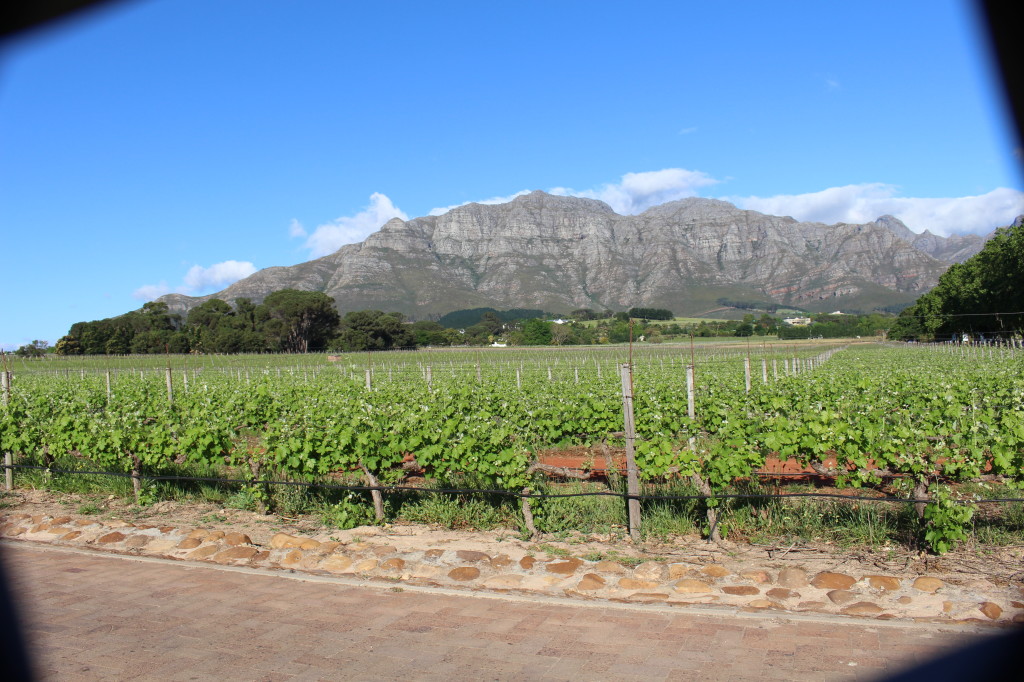
South Africa is among the top 10 wine producers in the world, producing more than 1,000,000 liters of wine per year. But while black and coloured* South Africans represent nearly 90% of the population, they remain woefully underrepresented in the $3 billion wine industry, at less than three percent. This great imbalance is a legacy of colonialism and South Africa’s apartheid past, when non-whites were prohibited from drinking or making wine and black ownership of land was limited.
Government land redistribution efforts and an affirmative action program known as Black Economic Empowerment (BEE) have been largely unsuccessful in increasing black ownership and participation in South Africa’s wine industry. Lack of collateral makes it near impossible for blacks to secure business loans from banks or funding from the government. Non-ownership of land, grapes or wineries and consumer reluctance to purchase wine brands with “African sounding” names have been additional obstacles. But despite these barriers, blacks are making inroads. Listed below are 10 black vineyards, winemakers and wine brands seeking to excel in South Africa’s competitive wine business.
Black Vineyards
Seven Sisters
Seven Sisters wine brand launched in 2007 and is owned and managed by coloured South African Vivian Kleynhans and her six sisters. The Seven Sisters wines are named after each sibling and the range consists of a Bukettraube (Odelia), Pinotage-Rose (Twena), Chenin Blanc (Yolanda), Sauvignon Blanc (Vivian), Pinotage/Shiraz (Dawn), Merlot (June) and Cabernet (Carol). The Seven Sisters vineyard, located in the Stellenbosch region of the Cape Winelands, is open to the public for tours and tastings by appointment. Seven Sisters can be contacted by phone at +27 710494109 or by email at vivian@africanrootswines.com. Seven Sisters wines are sold in the United States and South Africa.
M’Hudi
M’Hudi is a family enterprise owned and operated by the Rangakas, a black family who moved from Johannesburg to Cape Town in 2003 to realize their dream of owning a wine farm. With no prior winemaking experience, mother Malmsey, father Diale, and their three children, Tseliso, Lebogang, and Senyane have created a successful brand. M’hudi produces a “Premium” range (Sauvignon Blanc, Pinotage and Merlot) and an “On the Move” range (Chardonnay, Chenin Blanc, Pinotage, Shiraz and Cabernet Sauvignon). M’hudi’s Stellenbosch vineyard is currently closed to the public, but expected to re-open in April 2017. M’Hudi wines are sold in South Africa.
Thandi
Thandi was South Africa’s first agricultural BEE project and is owned by 147 farm worker families who hold 62% shares in the company. Thandi produces five ranges of wine: Reserve Range (Cabernet Sauvignon), Premium Range (Chardonnay, Merlot, Sauvignon Blanc and Shiraz), Pioneer Range (Chardonnay/Chenin Blanc, Shiraz/Cabernet Sauvignon, Shiraz/Rose, Sparkling Rose, Sparkling Red, and Sparking White), Rossouw Private Collection (Merlot/Cabernet and Pinotage) and JAC Range (Pinotage, Red Blend and Shiraz). Thandi’s Stellenbosch vineyard is open to the public for tastings, Monday through Thursday from 9:00 am to 5:00 pm and Friday from 9:00 am to 4:00 pm. Thandi wines are sold in Austria, Belgium, Canada, China, Finland, Germany, Hong Kong, Japan, Kenya, Norway, Russia, Sweden, South Korea, Sweden and South Africa.
Black Winemakers
Ntsiki Biyela
Ntsiki Biyela holds the distinction of being South Africa’s first black female winemaker. Biyela started her career in 2004 at the Stellenbosch vineyard of Stellekaya, where she is head winemaker. Biyela recently started her own Aslina wine brand, which is currently sold in the United States, Denmark and Germany. The Aslina brand will be sold in South Africa in 2017. Biyela has three Stellekaya varietals available at Wine for the World.
Carmen Stevens
Carmen Stevens is South Africa’s first coloured female winemaker and she has been the winemaker at Amani’s Stellenbosch vineyard since 2005. At Amani, Stevens makes a range of wines, including Sauvignon Blanc, Chardonnay, Rosé, Merlot, Shiraz, Pinotage, Cabernet Franc and a wine named I Am One, a Bordeaux/Shiraz blend. Stevens recently started her own wine brand, Angels Reserve, with the help of angel investors. Her wine can be purchased online at Naked Wines.
Heinrich Devon Keenen Kulsen
Heinrich Devon Keenen Kulsen is winemaker at Earthbound Wines, an organic and Fairtrade-certified range made from grapes supplied by Papkuilsfontein Vineyards in the Darling region of the Western Cape. The range consists of five varietals, four of which are organic: Sauvignon Blanc, Chenin Blanc, Pinotage, Cabernet Sauvignon and Pinot Noir (non-organic). Earthbound wines are sold in South Africa at Tops @ Spar and Darling Wine Shop, and online at Cyber Cellar.
Black Wine Brands
House of La RicMal
Malcolm and Ricardo Green are the father and son team behind the House of La RicMal, which has been in operation since 2008. Sourcing grapes from Darling, House of La RicMal produces two brands, La RicMal Supreme (Cabernet Sauvignon, Merlot, Shiraz, and Sauvignon Blanc) and Lerato (Classic Red, Sweet Red, and Classic White). House of RicMal brands are sold in South Africa at Pick and Pay, Checkers, Tops @ Spar, Liquor City and Agrimark and also exported to Nigeria, Ghana, Mozambique, Malawi, and Angola.
House of Mandela
Dr. Makaziwe Mandela and Tukwini Mandela (the daughter and granddaughter of late South African president and freedom fighter Nelson Mandela) are the mother and daughter team behind the House of Mandela. The House of Mandela produces varietals under five labels: Deep River (Cabernet Sauvignon/Merlot and Chenin Blanc/Chardonnay blends), Royal Reserve (Cabernet Sauvignon, Chardonnay and Shriaz), Thembu Collection (Cabernet Sauvignon, Merlot, Shiraz, Pinotage, Chenin Blanc, Chardonnay and Sauvignon Blanc), Vusani (Chenin Blanc and Pinotage) and Brut (Sparkling Wine). House of Mandela wines are sold in South Africa, the United States, Canada, Turks and Caicos, Brazil, Germany, Netherlands, Taiwan and Japan.
Ses’fikile
Ses’fikile is 100% owned and controlled by black women. Ses’fikile sources grapes from the Wellington area of the Western Cape and produces six wines: Chenin Blanc, Pinotage, Cabernet Sauvignon, Shiraz, Sauvignon Blanc and a Cabernet Sauvignon/Merlot blend. Private tastings can be arranged by phone at +27 83 431 0254 or by email at sesfikile@gmail.com. Ses’fikile wines are carried in select South African restaurants and hotels.
Women in Wine
Founded in 2006 by a group of 20 women, Women in Wine partners with existing cellars and bottling companies to produce its wine. The Women in Wine label produces six wines: Sauvignon Blanc, Cabernet Sauvignon, Chardonnay, Cabernet Sauvignon/Shiraz, Pinotage Rose, and Chardonnay Chenin Blanc. The Women in Wine brand is sold in the USA, China, Ireland, Spain, Sweden and Denmark, and in South Africa at Makro stores.
*In South Africa, the term Coloured is an ethnic label for people of mixed ethnic origin who possess ancestry from Europe, Asia, and various Khoisan and Bantu ethnic groups of southern Africa. For purposes of this article, the term Black is used to refer to persons who identify as Black or Coloured.
Have you visited any of these vineyards or tasted any of the wine brands? What did you think? Share your comments below.
Share This
The post 10 Black Vineyards, Winemakers and Wine Brands in South Africa first appeared on The Travel Sista.
]]>